Managing Finance in Health and Social Care: NHS Trust Hospital Project
VerifiedAdded on 2023/06/10
|20
|4727
|482
Report
AI Summary
This report provides a comprehensive financial analysis of an NHS Trust hospital's proposal to open a trust hospital. The analysis includes an executive summary, introduction, and detailed examination of the original and revised proposals. The report focuses on investment appraisal techniques such as payback period, accounting rate of return, and net present value to evaluate the financial viability of the project. The report compares the initial proposal, which was deemed financially unviable, with a revised proposal that aims to reduce expenses and increase revenue. Calculations and recommendations are provided based on these techniques, with the final recommendation to accept the revised proposal. The report highlights the importance of both financial and non-financial factors in making investment decisions and emphasizes the need for effective budget management to identify and control costs, ultimately aiming to maximize returns and improve healthcare facilities. The report is contributed by a student and is available on Desklib, a platform providing AI-based study tools for students.
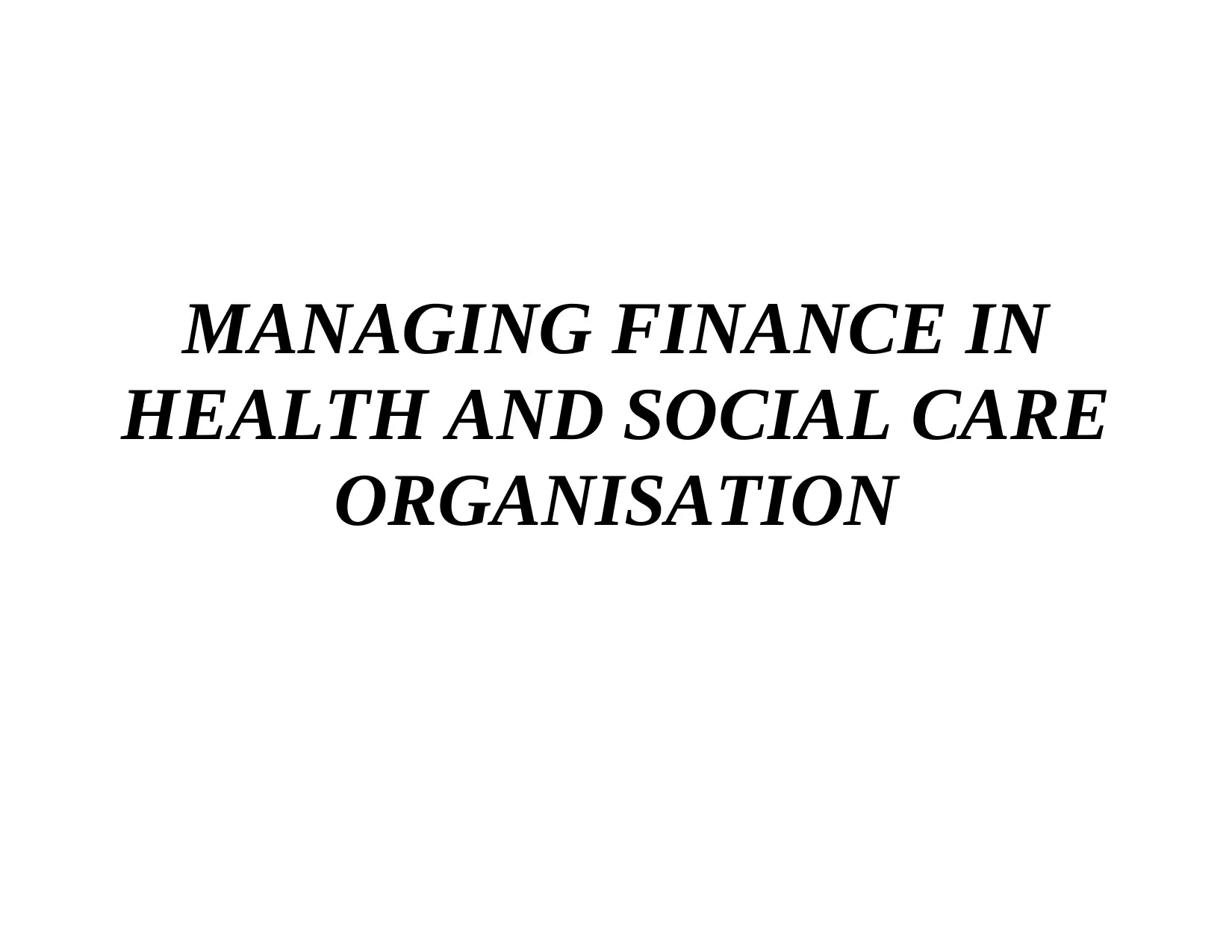
MANAGING FINANCE IN
HEALTH AND SOCIAL CARE
ORGANISATION
HEALTH AND SOCIAL CARE
ORGANISATION
Secure Best Marks with AI Grader
Need help grading? Try our AI Grader for instant feedback on your assignments.
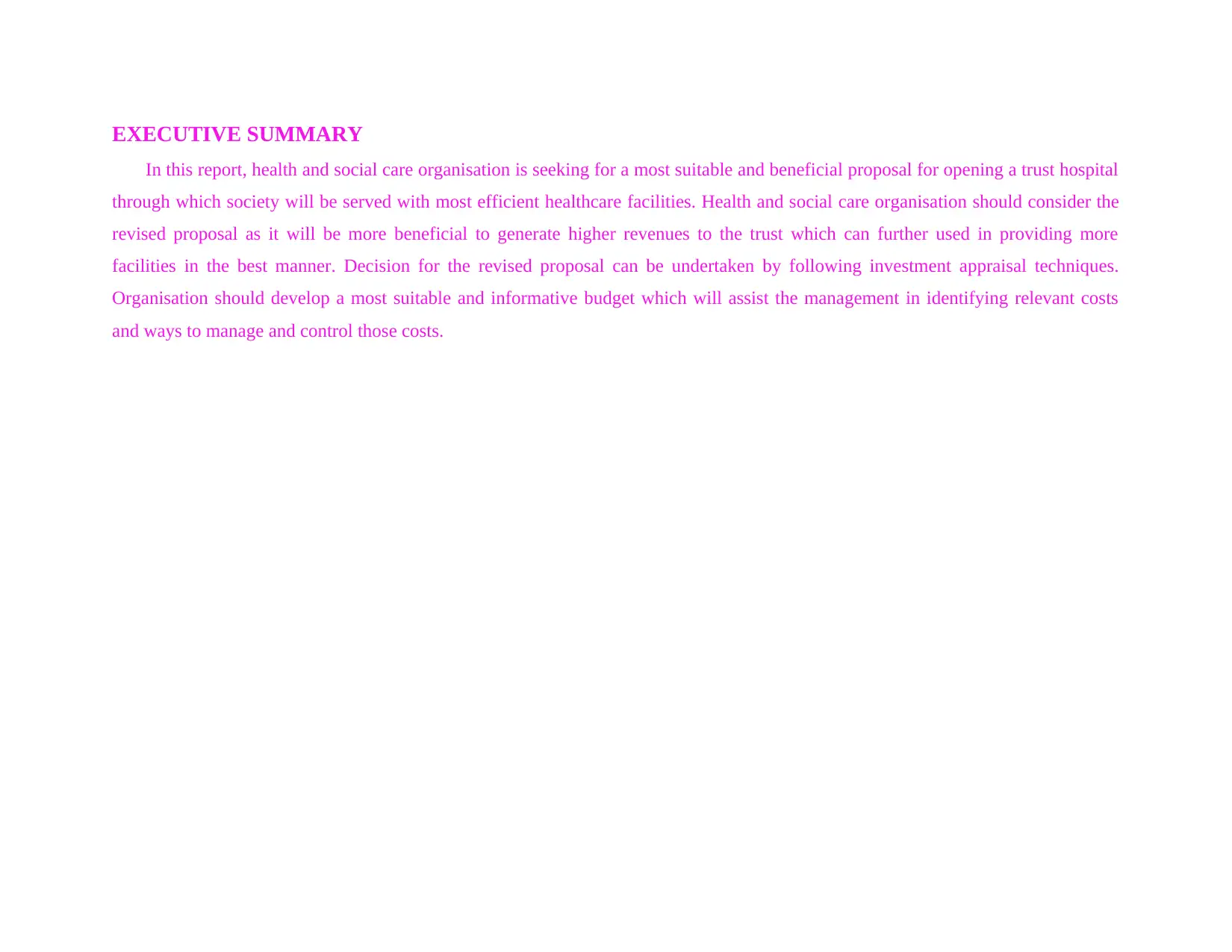
EXECUTIVE SUMMARY
In this report, health and social care organisation is seeking for a most suitable and beneficial proposal for opening a trust hospital
through which society will be served with most efficient healthcare facilities. Health and social care organisation should consider the
revised proposal as it will be more beneficial to generate higher revenues to the trust which can further used in providing more
facilities in the best manner. Decision for the revised proposal can be undertaken by following investment appraisal techniques.
Organisation should develop a most suitable and informative budget which will assist the management in identifying relevant costs
and ways to manage and control those costs.
In this report, health and social care organisation is seeking for a most suitable and beneficial proposal for opening a trust hospital
through which society will be served with most efficient healthcare facilities. Health and social care organisation should consider the
revised proposal as it will be more beneficial to generate higher revenues to the trust which can further used in providing more
facilities in the best manner. Decision for the revised proposal can be undertaken by following investment appraisal techniques.
Organisation should develop a most suitable and informative budget which will assist the management in identifying relevant costs
and ways to manage and control those costs.
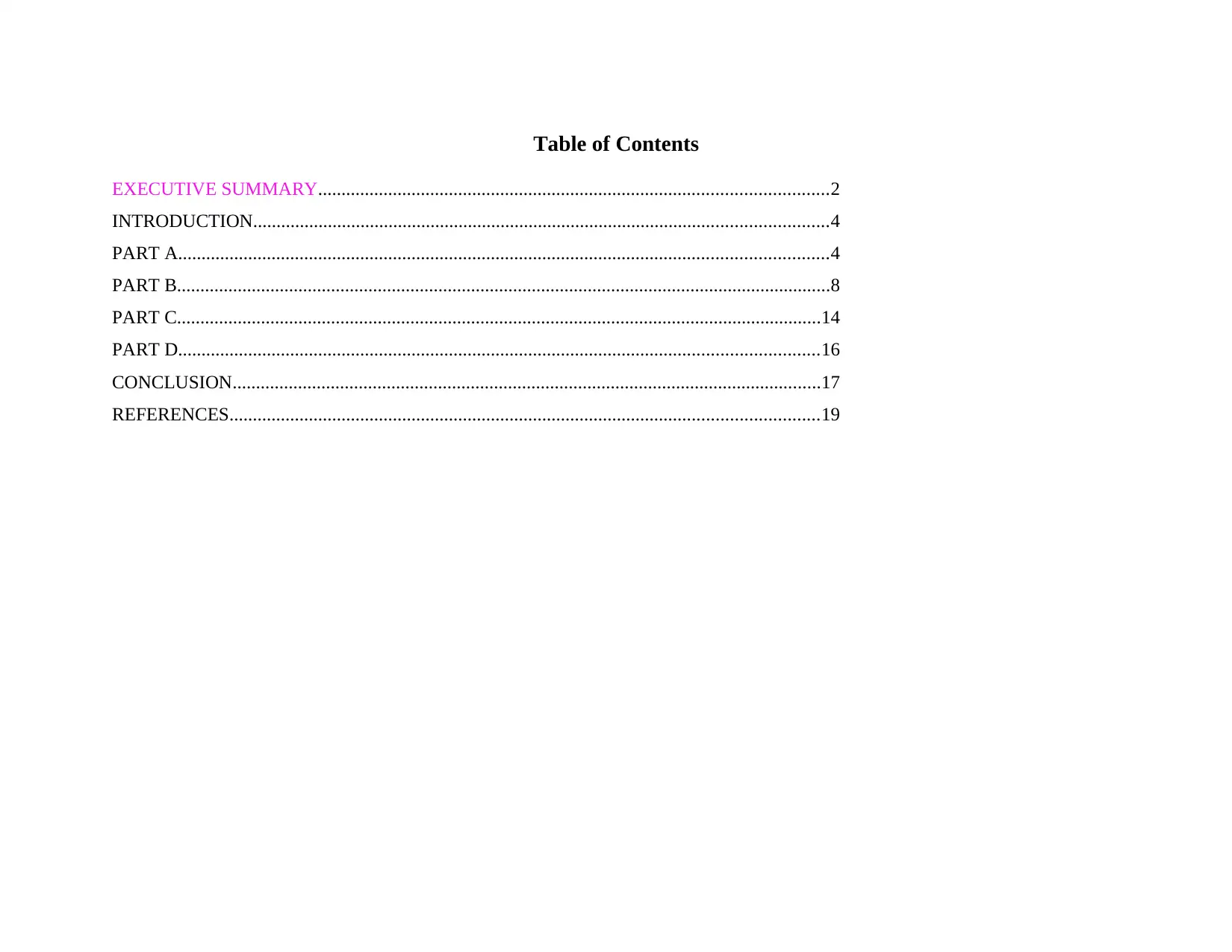
Table of Contents
EXECUTIVE SUMMARY.............................................................................................................2
INTRODUCTION...........................................................................................................................4
PART A...........................................................................................................................................4
PART B............................................................................................................................................8
PART C..........................................................................................................................................14
PART D.........................................................................................................................................16
CONCLUSION..............................................................................................................................17
REFERENCES..............................................................................................................................19
EXECUTIVE SUMMARY.............................................................................................................2
INTRODUCTION...........................................................................................................................4
PART A...........................................................................................................................................4
PART B............................................................................................................................................8
PART C..........................................................................................................................................14
PART D.........................................................................................................................................16
CONCLUSION..............................................................................................................................17
REFERENCES..............................................................................................................................19
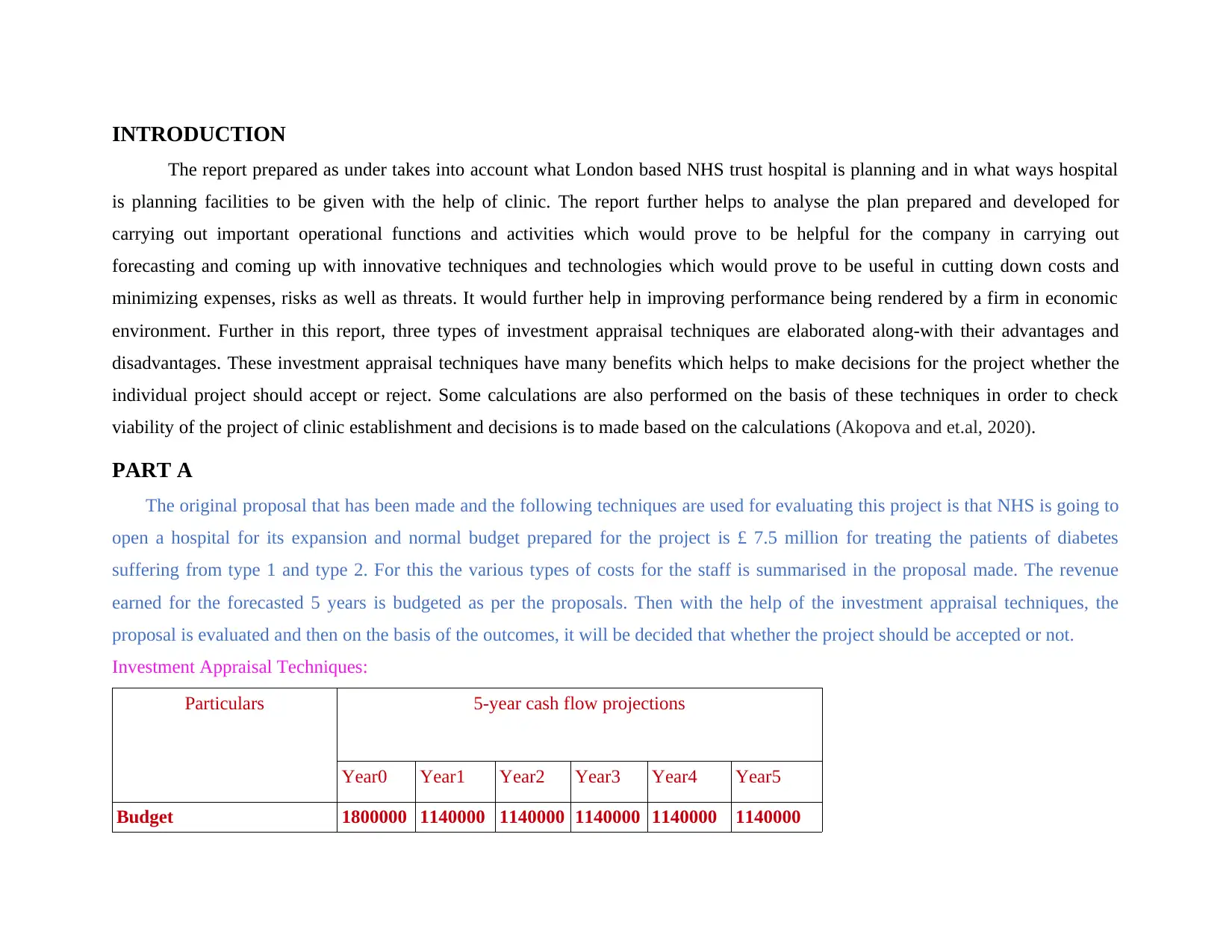
INTRODUCTION
The report prepared as under takes into account what London based NHS trust hospital is planning and in what ways hospital
is planning facilities to be given with the help of clinic. The report further helps to analyse the plan prepared and developed for
carrying out important operational functions and activities which would prove to be helpful for the company in carrying out
forecasting and coming up with innovative techniques and technologies which would prove to be useful in cutting down costs and
minimizing expenses, risks as well as threats. It would further help in improving performance being rendered by a firm in economic
environment. Further in this report, three types of investment appraisal techniques are elaborated along-with their advantages and
disadvantages. These investment appraisal techniques have many benefits which helps to make decisions for the project whether the
individual project should accept or reject. Some calculations are also performed on the basis of these techniques in order to check
viability of the project of clinic establishment and decisions is to made based on the calculations (Akopova and et.al, 2020).
PART A
The original proposal that has been made and the following techniques are used for evaluating this project is that NHS is going to
open a hospital for its expansion and normal budget prepared for the project is £ 7.5 million for treating the patients of diabetes
suffering from type 1 and type 2. For this the various types of costs for the staff is summarised in the proposal made. The revenue
earned for the forecasted 5 years is budgeted as per the proposals. Then with the help of the investment appraisal techniques, the
proposal is evaluated and then on the basis of the outcomes, it will be decided that whether the project should be accepted or not.
Investment Appraisal Techniques:
Particulars 5-year cash flow projections
Year0 Year1 Year2 Year3 Year4 Year5
Budget 1800000 1140000 1140000 1140000 1140000 1140000
The report prepared as under takes into account what London based NHS trust hospital is planning and in what ways hospital
is planning facilities to be given with the help of clinic. The report further helps to analyse the plan prepared and developed for
carrying out important operational functions and activities which would prove to be helpful for the company in carrying out
forecasting and coming up with innovative techniques and technologies which would prove to be useful in cutting down costs and
minimizing expenses, risks as well as threats. It would further help in improving performance being rendered by a firm in economic
environment. Further in this report, three types of investment appraisal techniques are elaborated along-with their advantages and
disadvantages. These investment appraisal techniques have many benefits which helps to make decisions for the project whether the
individual project should accept or reject. Some calculations are also performed on the basis of these techniques in order to check
viability of the project of clinic establishment and decisions is to made based on the calculations (Akopova and et.al, 2020).
PART A
The original proposal that has been made and the following techniques are used for evaluating this project is that NHS is going to
open a hospital for its expansion and normal budget prepared for the project is £ 7.5 million for treating the patients of diabetes
suffering from type 1 and type 2. For this the various types of costs for the staff is summarised in the proposal made. The revenue
earned for the forecasted 5 years is budgeted as per the proposals. Then with the help of the investment appraisal techniques, the
proposal is evaluated and then on the basis of the outcomes, it will be decided that whether the project should be accepted or not.
Investment Appraisal Techniques:
Particulars 5-year cash flow projections
Year0 Year1 Year2 Year3 Year4 Year5
Budget 1800000 1140000 1140000 1140000 1140000 1140000
Secure Best Marks with AI Grader
Need help grading? Try our AI Grader for instant feedback on your assignments.
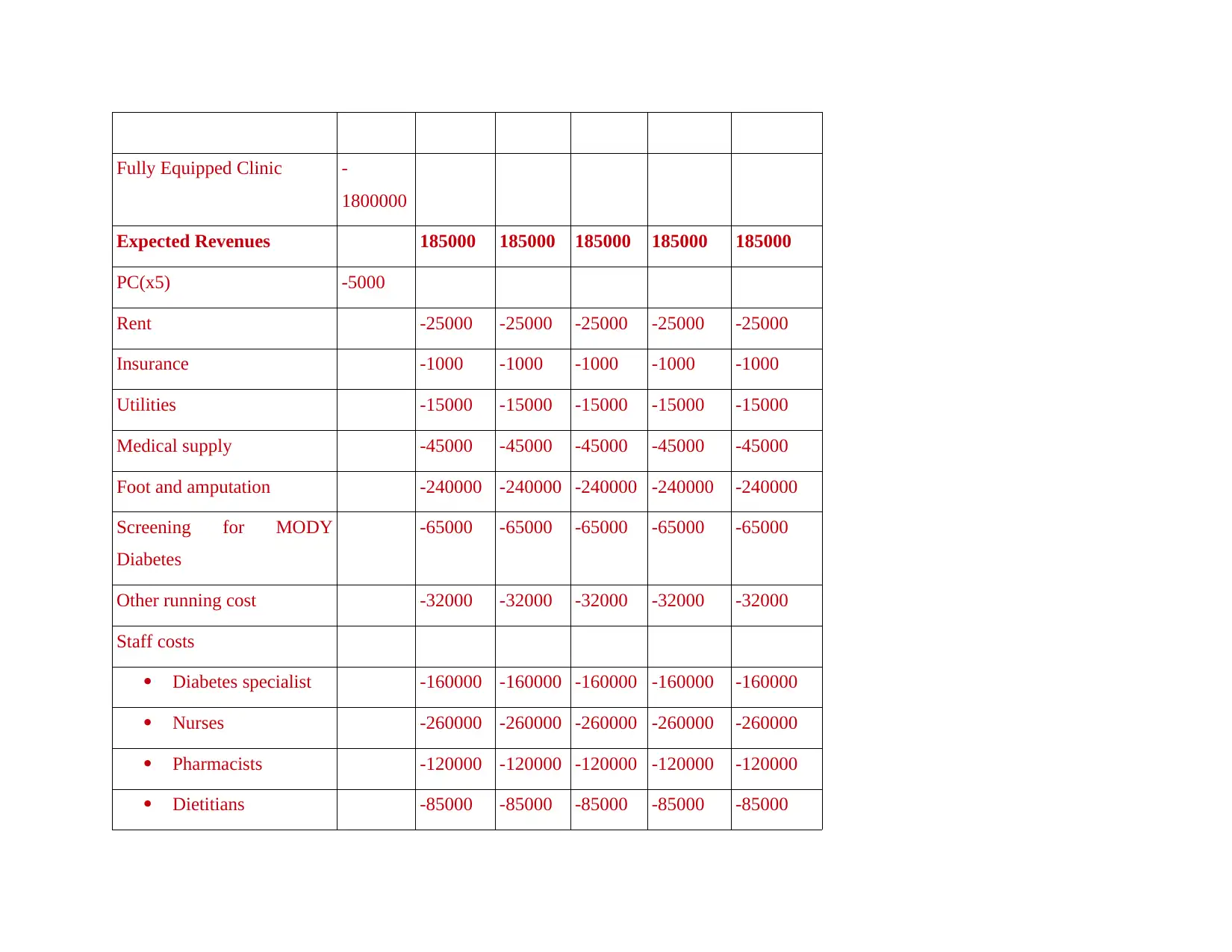
Fully Equipped Clinic -
1800000
Expected Revenues 185000 185000 185000 185000 185000
PC(x5) -5000
Rent -25000 -25000 -25000 -25000 -25000
Insurance -1000 -1000 -1000 -1000 -1000
Utilities -15000 -15000 -15000 -15000 -15000
Medical supply -45000 -45000 -45000 -45000 -45000
Foot and amputation -240000 -240000 -240000 -240000 -240000
Screening for MODY
Diabetes
-65000 -65000 -65000 -65000 -65000
Other running cost -32000 -32000 -32000 -32000 -32000
Staff costs
Diabetes specialist -160000 -160000 -160000 -160000 -160000
Nurses -260000 -260000 -260000 -260000 -260000
Pharmacists -120000 -120000 -120000 -120000 -120000
Dietitians -85000 -85000 -85000 -85000 -85000
1800000
Expected Revenues 185000 185000 185000 185000 185000
PC(x5) -5000
Rent -25000 -25000 -25000 -25000 -25000
Insurance -1000 -1000 -1000 -1000 -1000
Utilities -15000 -15000 -15000 -15000 -15000
Medical supply -45000 -45000 -45000 -45000 -45000
Foot and amputation -240000 -240000 -240000 -240000 -240000
Screening for MODY
Diabetes
-65000 -65000 -65000 -65000 -65000
Other running cost -32000 -32000 -32000 -32000 -32000
Staff costs
Diabetes specialist -160000 -160000 -160000 -160000 -160000
Nurses -260000 -260000 -260000 -260000 -260000
Pharmacists -120000 -120000 -120000 -120000 -120000
Dietitians -85000 -85000 -85000 -85000 -85000
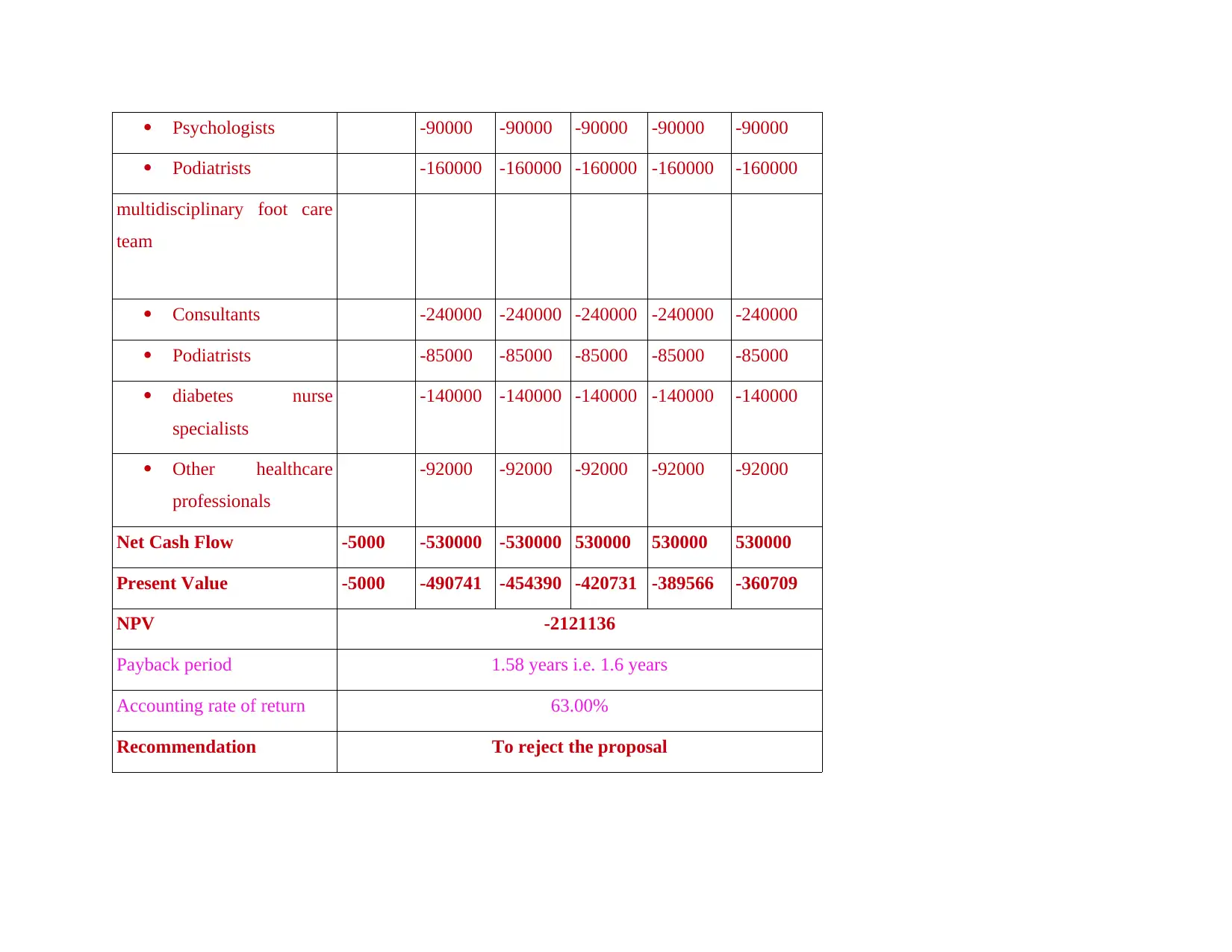
Psychologists -90000 -90000 -90000 -90000 -90000
Podiatrists -160000 -160000 -160000 -160000 -160000
multidisciplinary foot care
team
Consultants -240000 -240000 -240000 -240000 -240000
Podiatrists -85000 -85000 -85000 -85000 -85000
diabetes nurse
specialists
-140000 -140000 -140000 -140000 -140000
Other healthcare
professionals
-92000 -92000 -92000 -92000 -92000
Net Cash Flow -5000 -530000 -530000 530000 530000 530000
Present Value -5000 -490741 -454390 -420731 -389566 -360709
NPV -2121136
Payback period 1.58 years i.e. 1.6 years
Accounting rate of return 63.00%
Recommendation To reject the proposal
Podiatrists -160000 -160000 -160000 -160000 -160000
multidisciplinary foot care
team
Consultants -240000 -240000 -240000 -240000 -240000
Podiatrists -85000 -85000 -85000 -85000 -85000
diabetes nurse
specialists
-140000 -140000 -140000 -140000 -140000
Other healthcare
professionals
-92000 -92000 -92000 -92000 -92000
Net Cash Flow -5000 -530000 -530000 530000 530000 530000
Present Value -5000 -490741 -454390 -420731 -389566 -360709
NPV -2121136
Payback period 1.58 years i.e. 1.6 years
Accounting rate of return 63.00%
Recommendation To reject the proposal
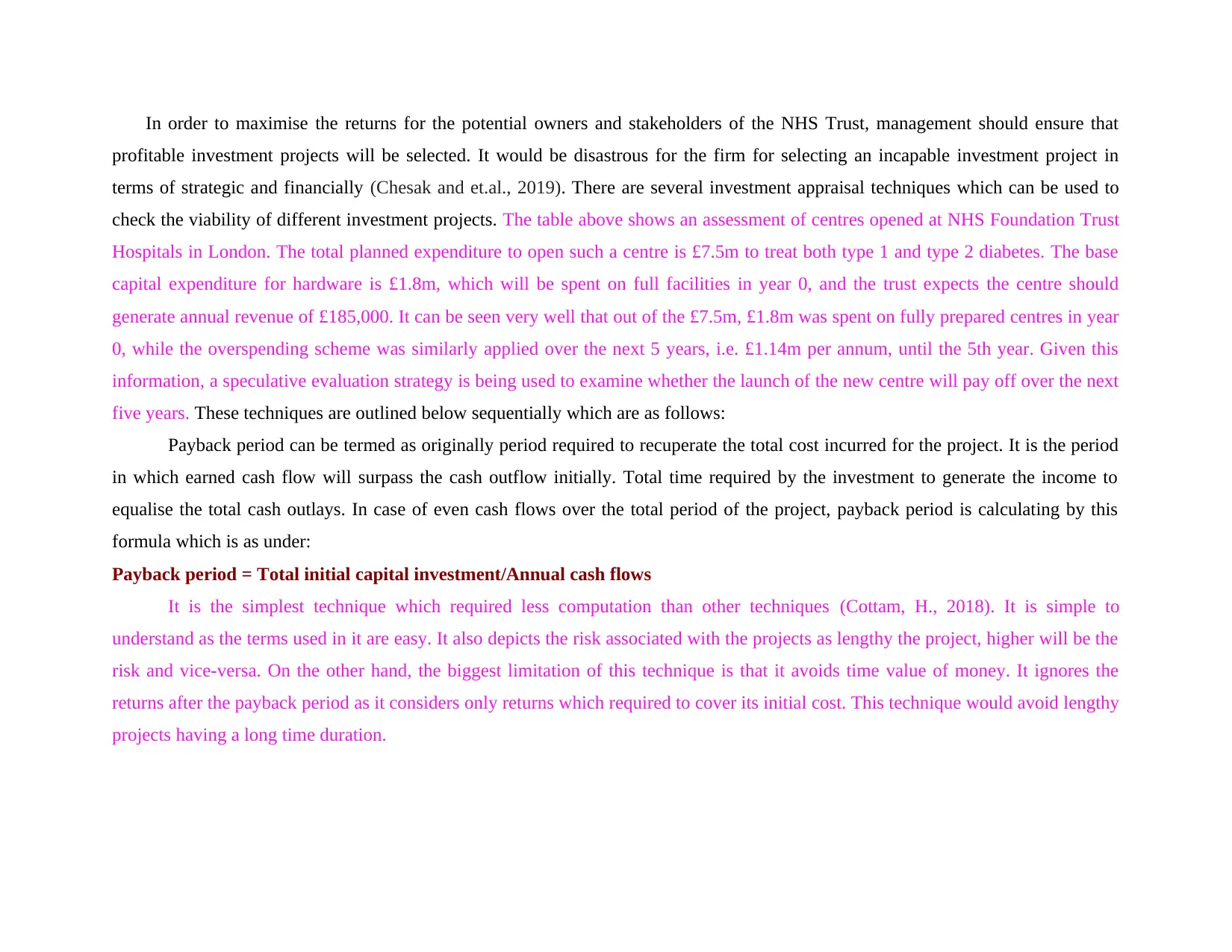
In order to maximise the returns for the potential owners and stakeholders of the NHS Trust, management should ensure that
profitable investment projects will be selected. It would be disastrous for the firm for selecting an incapable investment project in
terms of strategic and financially (Chesak and et.al., 2019). There are several investment appraisal techniques which can be used to
check the viability of different investment projects. The table above shows an assessment of centres opened at NHS Foundation Trust
Hospitals in London. The total planned expenditure to open such a centre is £7.5m to treat both type 1 and type 2 diabetes. The base
capital expenditure for hardware is £1.8m, which will be spent on full facilities in year 0, and the trust expects the centre should
generate annual revenue of £185,000. It can be seen very well that out of the £7.5m, £1.8m was spent on fully prepared centres in year
0, while the overspending scheme was similarly applied over the next 5 years, i.e. £1.14m per annum, until the 5th year. Given this
information, a speculative evaluation strategy is being used to examine whether the launch of the new centre will pay off over the next
five years. These techniques are outlined below sequentially which are as follows:
Payback period can be termed as originally period required to recuperate the total cost incurred for the project. It is the period
in which earned cash flow will surpass the cash outflow initially. Total time required by the investment to generate the income to
equalise the total cash outlays. In case of even cash flows over the total period of the project, payback period is calculating by this
formula which is as under:
Payback period = Total initial capital investment/Annual cash flows
It is the simplest technique which required less computation than other techniques (Cottam, H., 2018). It is simple to
understand as the terms used in it are easy. It also depicts the risk associated with the projects as lengthy the project, higher will be the
risk and vice-versa. On the other hand, the biggest limitation of this technique is that it avoids time value of money. It ignores the
returns after the payback period as it considers only returns which required to cover its initial cost. This technique would avoid lengthy
projects having a long time duration.
profitable investment projects will be selected. It would be disastrous for the firm for selecting an incapable investment project in
terms of strategic and financially (Chesak and et.al., 2019). There are several investment appraisal techniques which can be used to
check the viability of different investment projects. The table above shows an assessment of centres opened at NHS Foundation Trust
Hospitals in London. The total planned expenditure to open such a centre is £7.5m to treat both type 1 and type 2 diabetes. The base
capital expenditure for hardware is £1.8m, which will be spent on full facilities in year 0, and the trust expects the centre should
generate annual revenue of £185,000. It can be seen very well that out of the £7.5m, £1.8m was spent on fully prepared centres in year
0, while the overspending scheme was similarly applied over the next 5 years, i.e. £1.14m per annum, until the 5th year. Given this
information, a speculative evaluation strategy is being used to examine whether the launch of the new centre will pay off over the next
five years. These techniques are outlined below sequentially which are as follows:
Payback period can be termed as originally period required to recuperate the total cost incurred for the project. It is the period
in which earned cash flow will surpass the cash outflow initially. Total time required by the investment to generate the income to
equalise the total cash outlays. In case of even cash flows over the total period of the project, payback period is calculating by this
formula which is as under:
Payback period = Total initial capital investment/Annual cash flows
It is the simplest technique which required less computation than other techniques (Cottam, H., 2018). It is simple to
understand as the terms used in it are easy. It also depicts the risk associated with the projects as lengthy the project, higher will be the
risk and vice-versa. On the other hand, the biggest limitation of this technique is that it avoids time value of money. It ignores the
returns after the payback period as it considers only returns which required to cover its initial cost. This technique would avoid lengthy
projects having a long time duration.
Paraphrase This Document
Need a fresh take? Get an instant paraphrase of this document with our AI Paraphraser
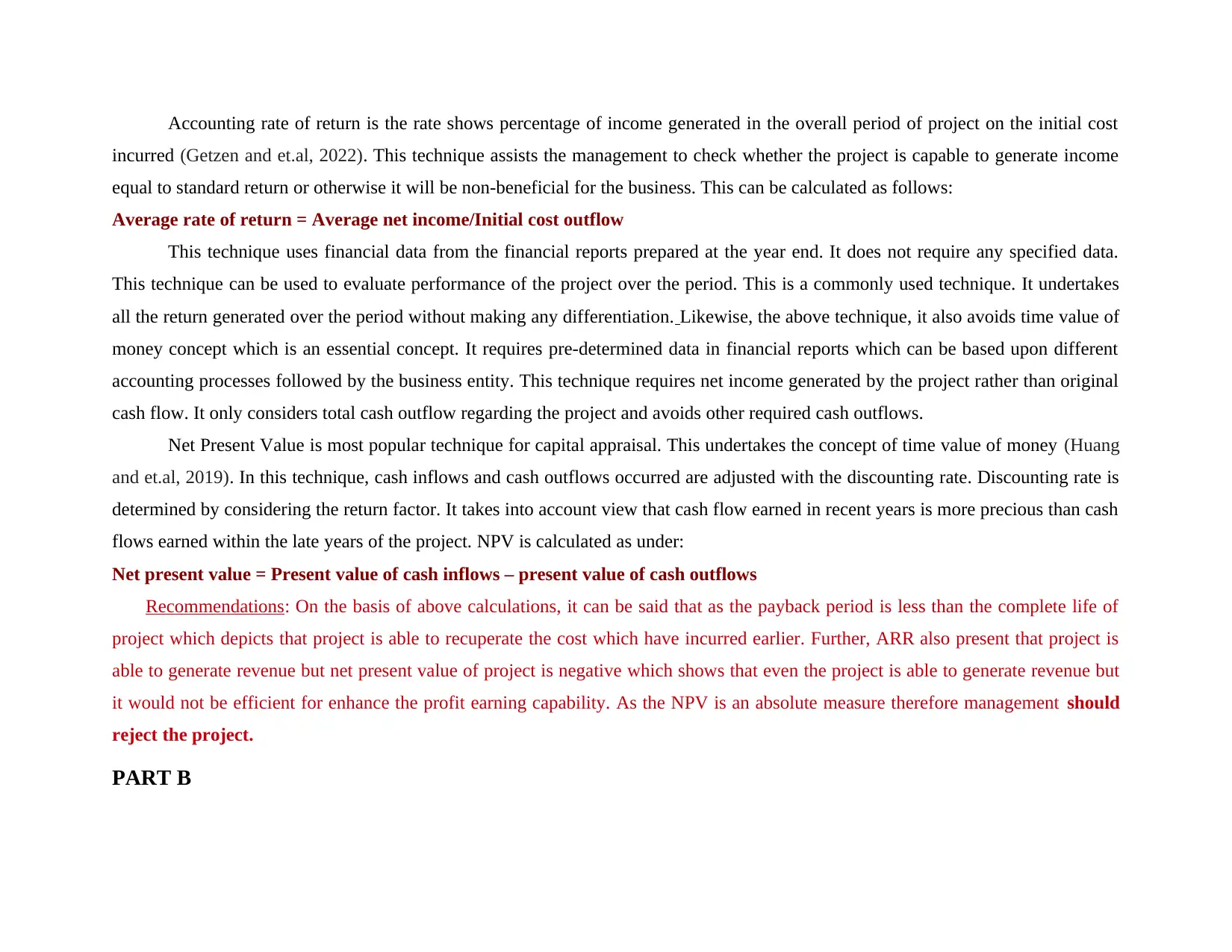
Accounting rate of return is the rate shows percentage of income generated in the overall period of project on the initial cost
incurred (Getzen and et.al, 2022). This technique assists the management to check whether the project is capable to generate income
equal to standard return or otherwise it will be non-beneficial for the business. This can be calculated as follows:
Average rate of return = Average net income/Initial cost outflow
This technique uses financial data from the financial reports prepared at the year end. It does not require any specified data.
This technique can be used to evaluate performance of the project over the period. This is a commonly used technique. It undertakes
all the return generated over the period without making any differentiation. Likewise, the above technique, it also avoids time value of
money concept which is an essential concept. It requires pre-determined data in financial reports which can be based upon different
accounting processes followed by the business entity. This technique requires net income generated by the project rather than original
cash flow. It only considers total cash outflow regarding the project and avoids other required cash outflows.
Net Present Value is most popular technique for capital appraisal. This undertakes the concept of time value of money (Huang
and et.al, 2019). In this technique, cash inflows and cash outflows occurred are adjusted with the discounting rate. Discounting rate is
determined by considering the return factor. It takes into account view that cash flow earned in recent years is more precious than cash
flows earned within the late years of the project. NPV is calculated as under:
Net present value = Present value of cash inflows – present value of cash outflows
Recommendations: On the basis of above calculations, it can be said that as the payback period is less than the complete life of
project which depicts that project is able to recuperate the cost which have incurred earlier. Further, ARR also present that project is
able to generate revenue but net present value of project is negative which shows that even the project is able to generate revenue but
it would not be efficient for enhance the profit earning capability. As the NPV is an absolute measure therefore management should
reject the project.
PART B
incurred (Getzen and et.al, 2022). This technique assists the management to check whether the project is capable to generate income
equal to standard return or otherwise it will be non-beneficial for the business. This can be calculated as follows:
Average rate of return = Average net income/Initial cost outflow
This technique uses financial data from the financial reports prepared at the year end. It does not require any specified data.
This technique can be used to evaluate performance of the project over the period. This is a commonly used technique. It undertakes
all the return generated over the period without making any differentiation. Likewise, the above technique, it also avoids time value of
money concept which is an essential concept. It requires pre-determined data in financial reports which can be based upon different
accounting processes followed by the business entity. This technique requires net income generated by the project rather than original
cash flow. It only considers total cash outflow regarding the project and avoids other required cash outflows.
Net Present Value is most popular technique for capital appraisal. This undertakes the concept of time value of money (Huang
and et.al, 2019). In this technique, cash inflows and cash outflows occurred are adjusted with the discounting rate. Discounting rate is
determined by considering the return factor. It takes into account view that cash flow earned in recent years is more precious than cash
flows earned within the late years of the project. NPV is calculated as under:
Net present value = Present value of cash inflows – present value of cash outflows
Recommendations: On the basis of above calculations, it can be said that as the payback period is less than the complete life of
project which depicts that project is able to recuperate the cost which have incurred earlier. Further, ARR also present that project is
able to generate revenue but net present value of project is negative which shows that even the project is able to generate revenue but
it would not be efficient for enhance the profit earning capability. As the NPV is an absolute measure therefore management should
reject the project.
PART B
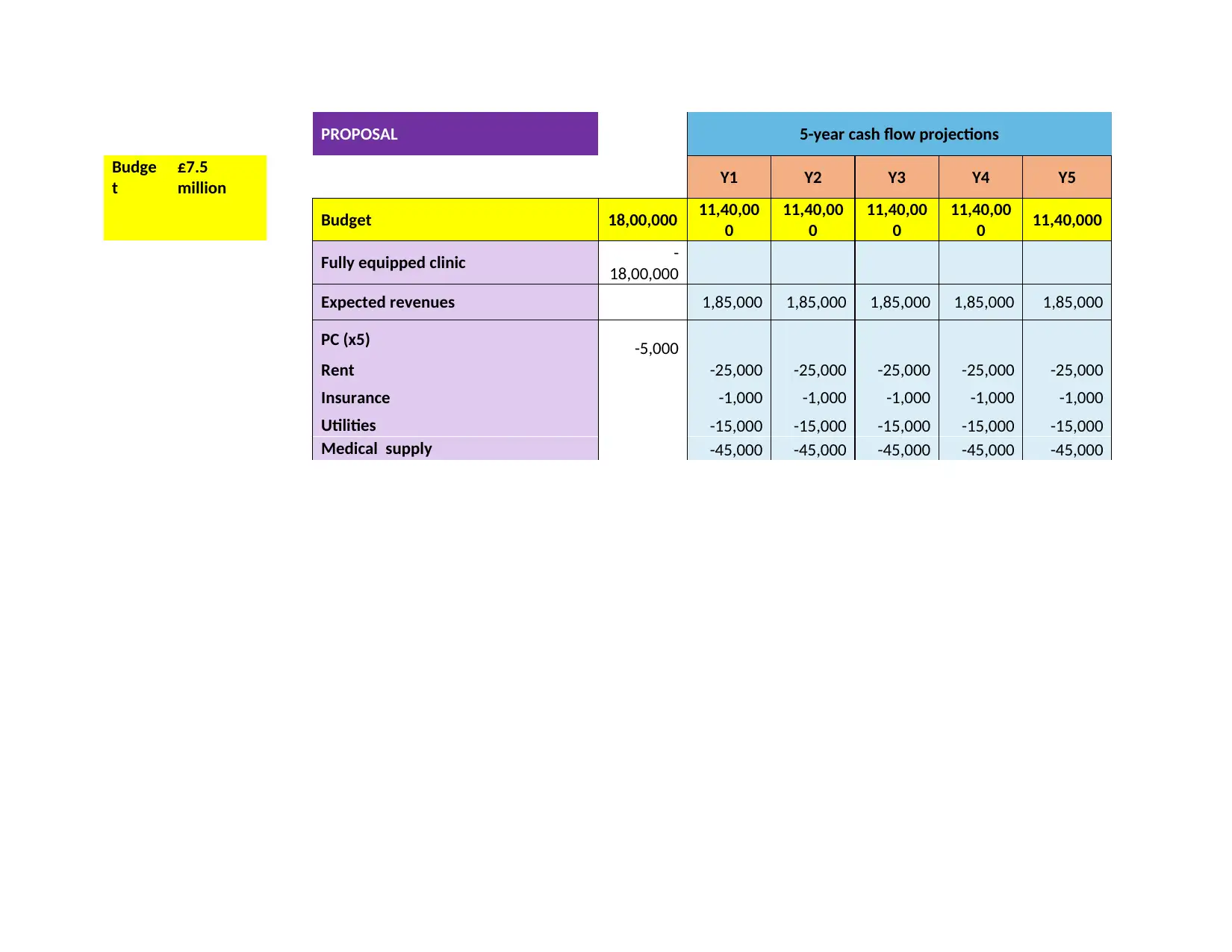
PROPOSAL 5-year cash flow projections
Budge
t
£7.5
million Y1 Y2 Y3 Y4 Y5
Budget 18,00,000 11,40,00
0
11,40,00
0
11,40,00
0
11,40,00
0 11,40,000
Fully equipped clinic -
18,00,000
Expected revenues 1,85,000 1,85,000 1,85,000 1,85,000 1,85,000
PC (x5) -5,000
Rent -25,000 -25,000 -25,000 -25,000 -25,000
Insurance -1,000 -1,000 -1,000 -1,000 -1,000
Utilities -15,000 -15,000 -15,000 -15,000 -15,000
Medical supply -45,000 -45,000 -45,000 -45,000 -45,000
Budge
t
£7.5
million Y1 Y2 Y3 Y4 Y5
Budget 18,00,000 11,40,00
0
11,40,00
0
11,40,00
0
11,40,00
0 11,40,000
Fully equipped clinic -
18,00,000
Expected revenues 1,85,000 1,85,000 1,85,000 1,85,000 1,85,000
PC (x5) -5,000
Rent -25,000 -25,000 -25,000 -25,000 -25,000
Insurance -1,000 -1,000 -1,000 -1,000 -1,000
Utilities -15,000 -15,000 -15,000 -15,000 -15,000
Medical supply -45,000 -45,000 -45,000 -45,000 -45,000
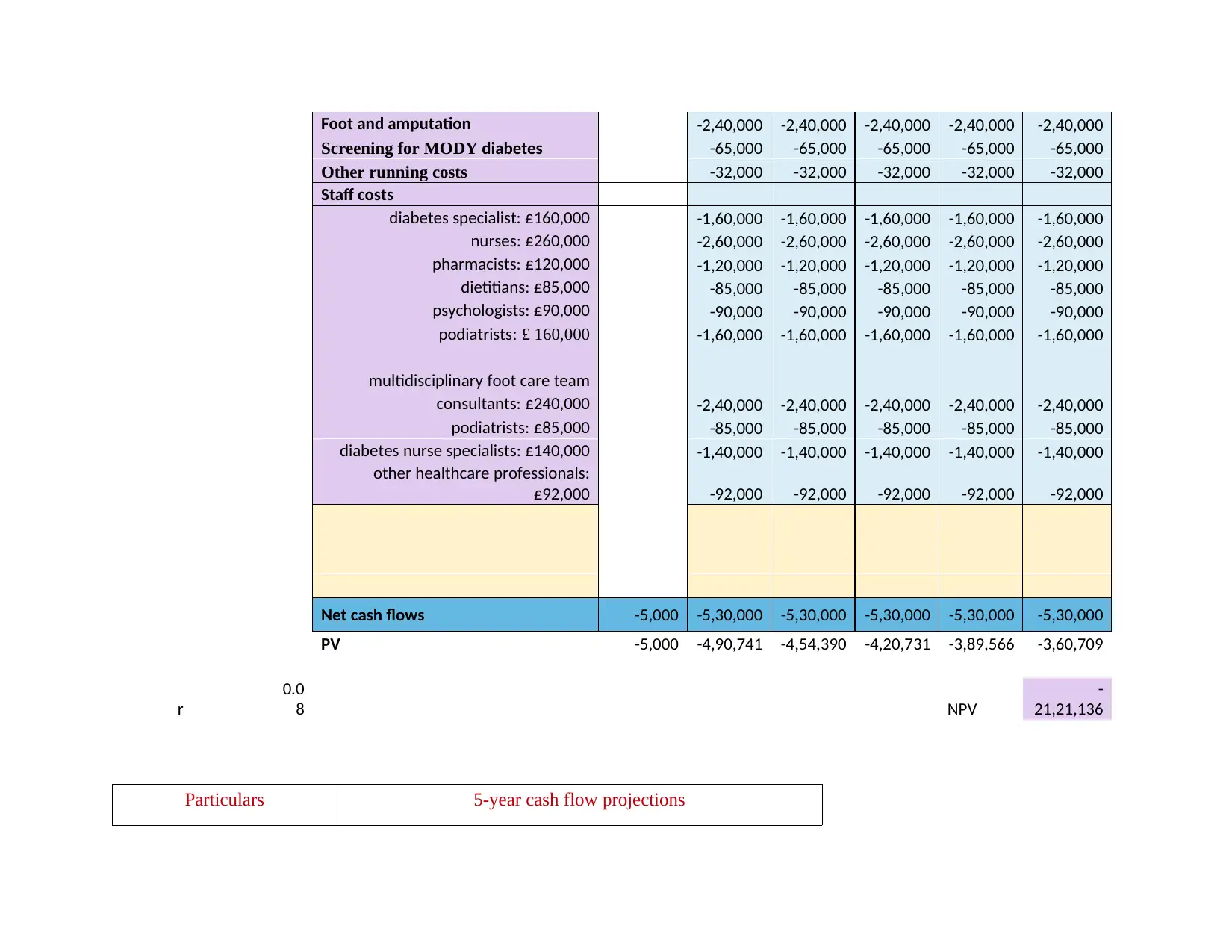
Foot and amputation -2,40,000 -2,40,000 -2,40,000 -2,40,000 -2,40,000
Screening for MODY diabetes -65,000 -65,000 -65,000 -65,000 -65,000
Other running costs -32,000 -32,000 -32,000 -32,000 -32,000
Staff costs
diabetes specialist: £160,000 -1,60,000 -1,60,000 -1,60,000 -1,60,000 -1,60,000
nurses: £260,000 -2,60,000 -2,60,000 -2,60,000 -2,60,000 -2,60,000
pharmacists: £120,000 -1,20,000 -1,20,000 -1,20,000 -1,20,000 -1,20,000
dietitians: £85,000 -85,000 -85,000 -85,000 -85,000 -85,000
psychologists: £90,000 -90,000 -90,000 -90,000 -90,000 -90,000
podiatrists: £ 160,000 -1,60,000 -1,60,000 -1,60,000 -1,60,000 -1,60,000
multidisciplinary foot care team
consultants: £240,000 -2,40,000 -2,40,000 -2,40,000 -2,40,000 -2,40,000
podiatrists: £85,000 -85,000 -85,000 -85,000 -85,000 -85,000
diabetes nurse specialists: £140,000 -1,40,000 -1,40,000 -1,40,000 -1,40,000 -1,40,000
other healthcare professionals:
£92,000 -92,000 -92,000 -92,000 -92,000 -92,000
Net cash flows -5,000 -5,30,000 -5,30,000 -5,30,000 -5,30,000 -5,30,000
PV -5,000 -4,90,741 -4,54,390 -4,20,731 -3,89,566 -3,60,709
r
0.0
8 NPV
-
21,21,136
Particulars 5-year cash flow projections
Screening for MODY diabetes -65,000 -65,000 -65,000 -65,000 -65,000
Other running costs -32,000 -32,000 -32,000 -32,000 -32,000
Staff costs
diabetes specialist: £160,000 -1,60,000 -1,60,000 -1,60,000 -1,60,000 -1,60,000
nurses: £260,000 -2,60,000 -2,60,000 -2,60,000 -2,60,000 -2,60,000
pharmacists: £120,000 -1,20,000 -1,20,000 -1,20,000 -1,20,000 -1,20,000
dietitians: £85,000 -85,000 -85,000 -85,000 -85,000 -85,000
psychologists: £90,000 -90,000 -90,000 -90,000 -90,000 -90,000
podiatrists: £ 160,000 -1,60,000 -1,60,000 -1,60,000 -1,60,000 -1,60,000
multidisciplinary foot care team
consultants: £240,000 -2,40,000 -2,40,000 -2,40,000 -2,40,000 -2,40,000
podiatrists: £85,000 -85,000 -85,000 -85,000 -85,000 -85,000
diabetes nurse specialists: £140,000 -1,40,000 -1,40,000 -1,40,000 -1,40,000 -1,40,000
other healthcare professionals:
£92,000 -92,000 -92,000 -92,000 -92,000 -92,000
Net cash flows -5,000 -5,30,000 -5,30,000 -5,30,000 -5,30,000 -5,30,000
PV -5,000 -4,90,741 -4,54,390 -4,20,731 -3,89,566 -3,60,709
r
0.0
8 NPV
-
21,21,136
Particulars 5-year cash flow projections
Secure Best Marks with AI Grader
Need help grading? Try our AI Grader for instant feedback on your assignments.
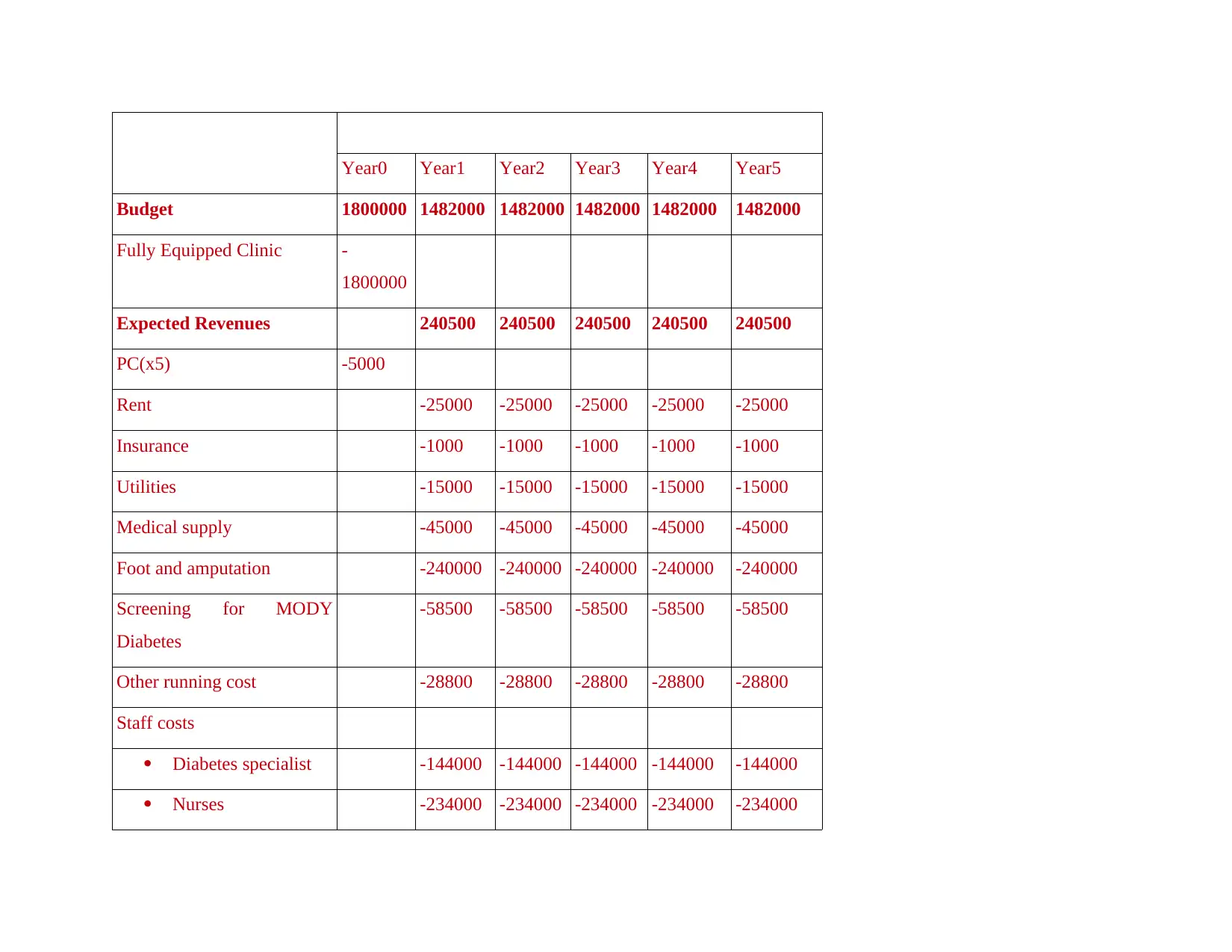
Year0 Year1 Year2 Year3 Year4 Year5
Budget 1800000 1482000 1482000 1482000 1482000 1482000
Fully Equipped Clinic -
1800000
Expected Revenues 240500 240500 240500 240500 240500
PC(x5) -5000
Rent -25000 -25000 -25000 -25000 -25000
Insurance -1000 -1000 -1000 -1000 -1000
Utilities -15000 -15000 -15000 -15000 -15000
Medical supply -45000 -45000 -45000 -45000 -45000
Foot and amputation -240000 -240000 -240000 -240000 -240000
Screening for MODY
Diabetes
-58500 -58500 -58500 -58500 -58500
Other running cost -28800 -28800 -28800 -28800 -28800
Staff costs
Diabetes specialist -144000 -144000 -144000 -144000 -144000
Nurses -234000 -234000 -234000 -234000 -234000
Budget 1800000 1482000 1482000 1482000 1482000 1482000
Fully Equipped Clinic -
1800000
Expected Revenues 240500 240500 240500 240500 240500
PC(x5) -5000
Rent -25000 -25000 -25000 -25000 -25000
Insurance -1000 -1000 -1000 -1000 -1000
Utilities -15000 -15000 -15000 -15000 -15000
Medical supply -45000 -45000 -45000 -45000 -45000
Foot and amputation -240000 -240000 -240000 -240000 -240000
Screening for MODY
Diabetes
-58500 -58500 -58500 -58500 -58500
Other running cost -28800 -28800 -28800 -28800 -28800
Staff costs
Diabetes specialist -144000 -144000 -144000 -144000 -144000
Nurses -234000 -234000 -234000 -234000 -234000
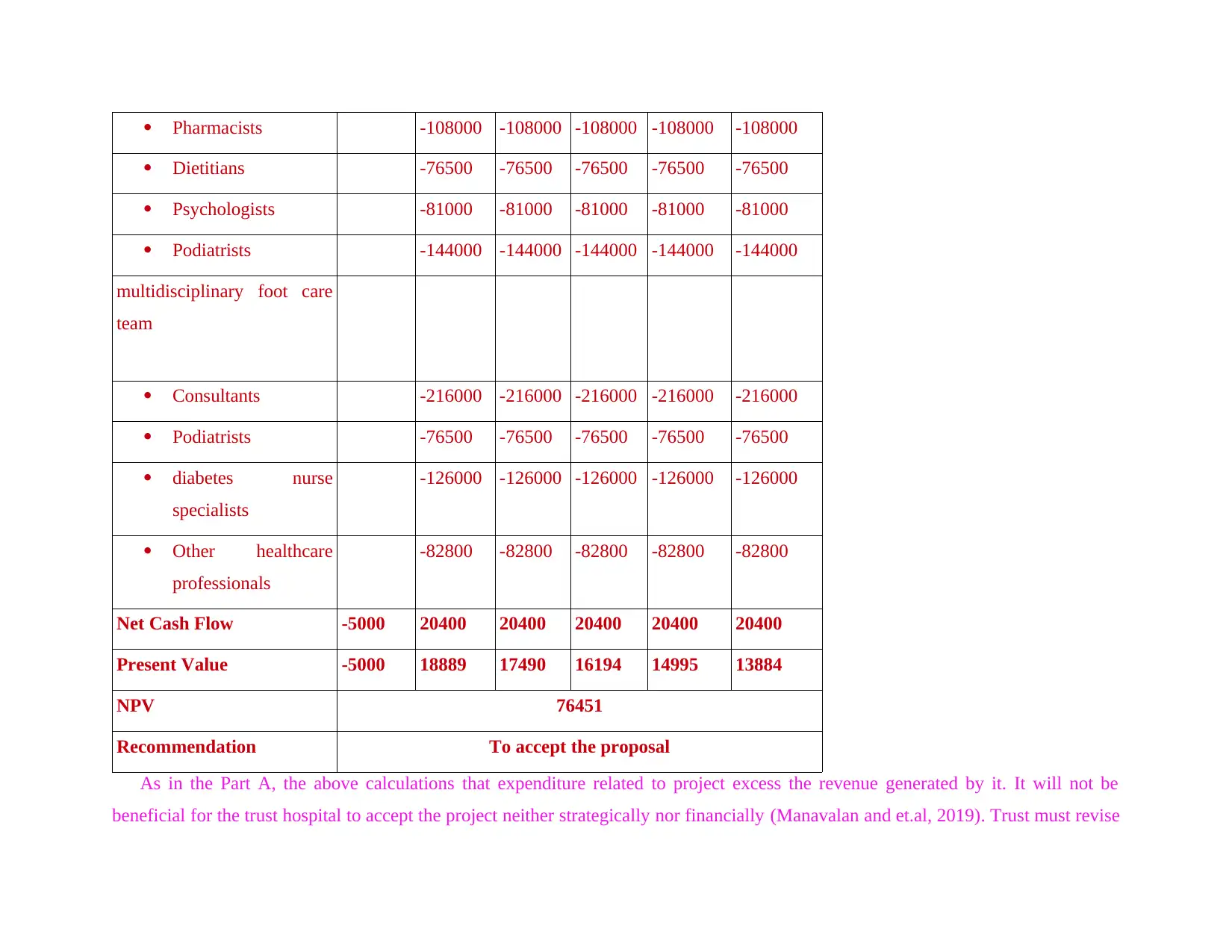
Pharmacists -108000 -108000 -108000 -108000 -108000
Dietitians -76500 -76500 -76500 -76500 -76500
Psychologists -81000 -81000 -81000 -81000 -81000
Podiatrists -144000 -144000 -144000 -144000 -144000
multidisciplinary foot care
team
Consultants -216000 -216000 -216000 -216000 -216000
Podiatrists -76500 -76500 -76500 -76500 -76500
diabetes nurse
specialists
-126000 -126000 -126000 -126000 -126000
Other healthcare
professionals
-82800 -82800 -82800 -82800 -82800
Net Cash Flow -5000 20400 20400 20400 20400 20400
Present Value -5000 18889 17490 16194 14995 13884
NPV 76451
Recommendation To accept the proposal
As in the Part A, the above calculations that expenditure related to project excess the revenue generated by it. It will not be
beneficial for the trust hospital to accept the project neither strategically nor financially (Manavalan and et.al, 2019). Trust must revise
Dietitians -76500 -76500 -76500 -76500 -76500
Psychologists -81000 -81000 -81000 -81000 -81000
Podiatrists -144000 -144000 -144000 -144000 -144000
multidisciplinary foot care
team
Consultants -216000 -216000 -216000 -216000 -216000
Podiatrists -76500 -76500 -76500 -76500 -76500
diabetes nurse
specialists
-126000 -126000 -126000 -126000 -126000
Other healthcare
professionals
-82800 -82800 -82800 -82800 -82800
Net Cash Flow -5000 20400 20400 20400 20400 20400
Present Value -5000 18889 17490 16194 14995 13884
NPV 76451
Recommendation To accept the proposal
As in the Part A, the above calculations that expenditure related to project excess the revenue generated by it. It will not be
beneficial for the trust hospital to accept the project neither strategically nor financially (Manavalan and et.al, 2019). Trust must revise
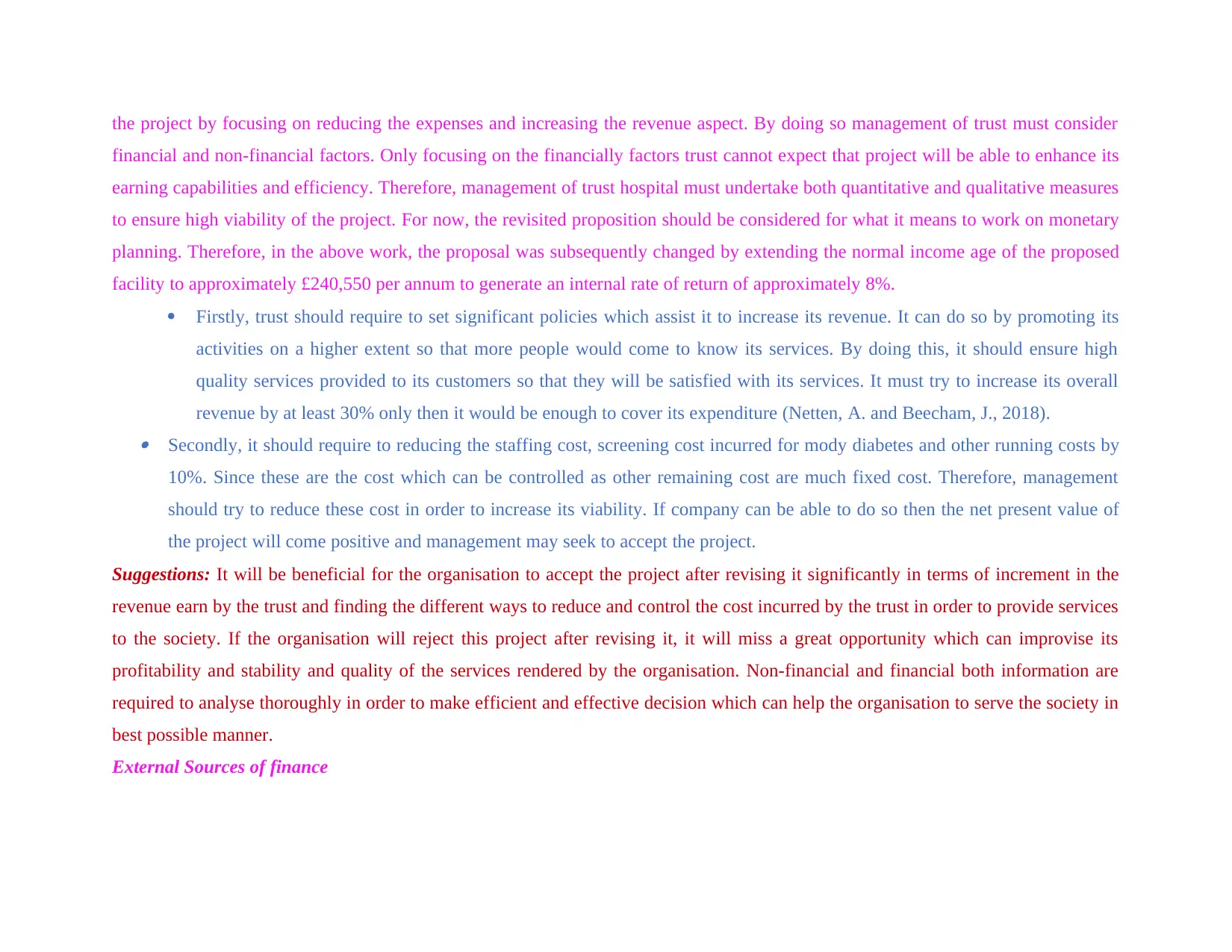
the project by focusing on reducing the expenses and increasing the revenue aspect. By doing so management of trust must consider
financial and non-financial factors. Only focusing on the financially factors trust cannot expect that project will be able to enhance its
earning capabilities and efficiency. Therefore, management of trust hospital must undertake both quantitative and qualitative measures
to ensure high viability of the project. For now, the revisited proposition should be considered for what it means to work on monetary
planning. Therefore, in the above work, the proposal was subsequently changed by extending the normal income age of the proposed
facility to approximately £240,550 per annum to generate an internal rate of return of approximately 8%.
Firstly, trust should require to set significant policies which assist it to increase its revenue. It can do so by promoting its
activities on a higher extent so that more people would come to know its services. By doing this, it should ensure high
quality services provided to its customers so that they will be satisfied with its services. It must try to increase its overall
revenue by at least 30% only then it would be enough to cover its expenditure (Netten, A. and Beecham, J., 2018). Secondly, it should require to reducing the staffing cost, screening cost incurred for mody diabetes and other running costs by
10%. Since these are the cost which can be controlled as other remaining cost are much fixed cost. Therefore, management
should try to reduce these cost in order to increase its viability. If company can be able to do so then the net present value of
the project will come positive and management may seek to accept the project.
Suggestions: It will be beneficial for the organisation to accept the project after revising it significantly in terms of increment in the
revenue earn by the trust and finding the different ways to reduce and control the cost incurred by the trust in order to provide services
to the society. If the organisation will reject this project after revising it, it will miss a great opportunity which can improvise its
profitability and stability and quality of the services rendered by the organisation. Non-financial and financial both information are
required to analyse thoroughly in order to make efficient and effective decision which can help the organisation to serve the society in
best possible manner.
External Sources of finance
financial and non-financial factors. Only focusing on the financially factors trust cannot expect that project will be able to enhance its
earning capabilities and efficiency. Therefore, management of trust hospital must undertake both quantitative and qualitative measures
to ensure high viability of the project. For now, the revisited proposition should be considered for what it means to work on monetary
planning. Therefore, in the above work, the proposal was subsequently changed by extending the normal income age of the proposed
facility to approximately £240,550 per annum to generate an internal rate of return of approximately 8%.
Firstly, trust should require to set significant policies which assist it to increase its revenue. It can do so by promoting its
activities on a higher extent so that more people would come to know its services. By doing this, it should ensure high
quality services provided to its customers so that they will be satisfied with its services. It must try to increase its overall
revenue by at least 30% only then it would be enough to cover its expenditure (Netten, A. and Beecham, J., 2018). Secondly, it should require to reducing the staffing cost, screening cost incurred for mody diabetes and other running costs by
10%. Since these are the cost which can be controlled as other remaining cost are much fixed cost. Therefore, management
should try to reduce these cost in order to increase its viability. If company can be able to do so then the net present value of
the project will come positive and management may seek to accept the project.
Suggestions: It will be beneficial for the organisation to accept the project after revising it significantly in terms of increment in the
revenue earn by the trust and finding the different ways to reduce and control the cost incurred by the trust in order to provide services
to the society. If the organisation will reject this project after revising it, it will miss a great opportunity which can improvise its
profitability and stability and quality of the services rendered by the organisation. Non-financial and financial both information are
required to analyse thoroughly in order to make efficient and effective decision which can help the organisation to serve the society in
best possible manner.
External Sources of finance
Paraphrase This Document
Need a fresh take? Get an instant paraphrase of this document with our AI Paraphraser
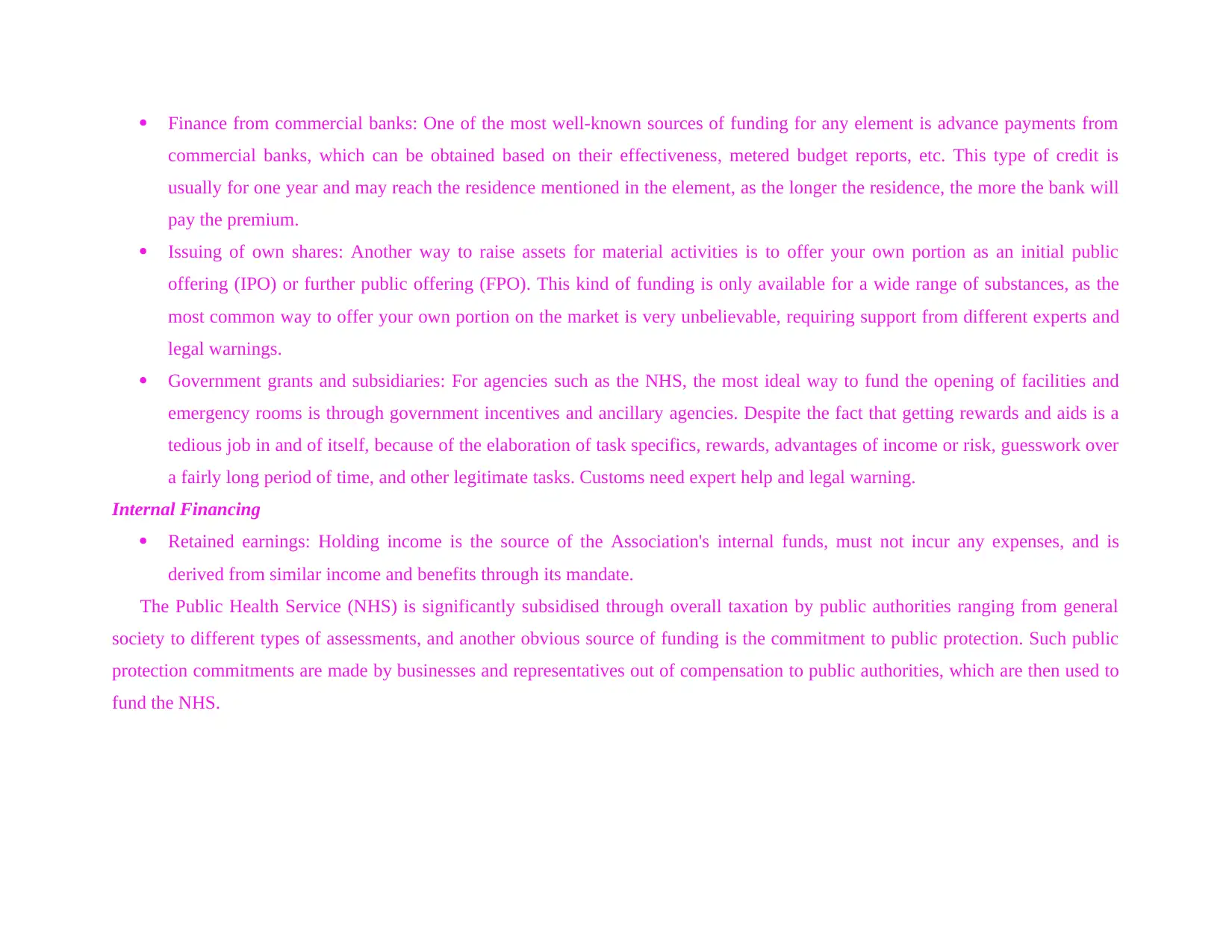
Finance from commercial banks: One of the most well-known sources of funding for any element is advance payments from
commercial banks, which can be obtained based on their effectiveness, metered budget reports, etc. This type of credit is
usually for one year and may reach the residence mentioned in the element, as the longer the residence, the more the bank will
pay the premium.
Issuing of own shares: Another way to raise assets for material activities is to offer your own portion as an initial public
offering (IPO) or further public offering (FPO). This kind of funding is only available for a wide range of substances, as the
most common way to offer your own portion on the market is very unbelievable, requiring support from different experts and
legal warnings.
Government grants and subsidiaries: For agencies such as the NHS, the most ideal way to fund the opening of facilities and
emergency rooms is through government incentives and ancillary agencies. Despite the fact that getting rewards and aids is a
tedious job in and of itself, because of the elaboration of task specifics, rewards, advantages of income or risk, guesswork over
a fairly long period of time, and other legitimate tasks. Customs need expert help and legal warning.
Internal Financing
Retained earnings: Holding income is the source of the Association's internal funds, must not incur any expenses, and is
derived from similar income and benefits through its mandate.
The Public Health Service (NHS) is significantly subsidised through overall taxation by public authorities ranging from general
society to different types of assessments, and another obvious source of funding is the commitment to public protection. Such public
protection commitments are made by businesses and representatives out of compensation to public authorities, which are then used to
fund the NHS.
commercial banks, which can be obtained based on their effectiveness, metered budget reports, etc. This type of credit is
usually for one year and may reach the residence mentioned in the element, as the longer the residence, the more the bank will
pay the premium.
Issuing of own shares: Another way to raise assets for material activities is to offer your own portion as an initial public
offering (IPO) or further public offering (FPO). This kind of funding is only available for a wide range of substances, as the
most common way to offer your own portion on the market is very unbelievable, requiring support from different experts and
legal warnings.
Government grants and subsidiaries: For agencies such as the NHS, the most ideal way to fund the opening of facilities and
emergency rooms is through government incentives and ancillary agencies. Despite the fact that getting rewards and aids is a
tedious job in and of itself, because of the elaboration of task specifics, rewards, advantages of income or risk, guesswork over
a fairly long period of time, and other legitimate tasks. Customs need expert help and legal warning.
Internal Financing
Retained earnings: Holding income is the source of the Association's internal funds, must not incur any expenses, and is
derived from similar income and benefits through its mandate.
The Public Health Service (NHS) is significantly subsidised through overall taxation by public authorities ranging from general
society to different types of assessments, and another obvious source of funding is the commitment to public protection. Such public
protection commitments are made by businesses and representatives out of compensation to public authorities, which are then used to
fund the NHS.
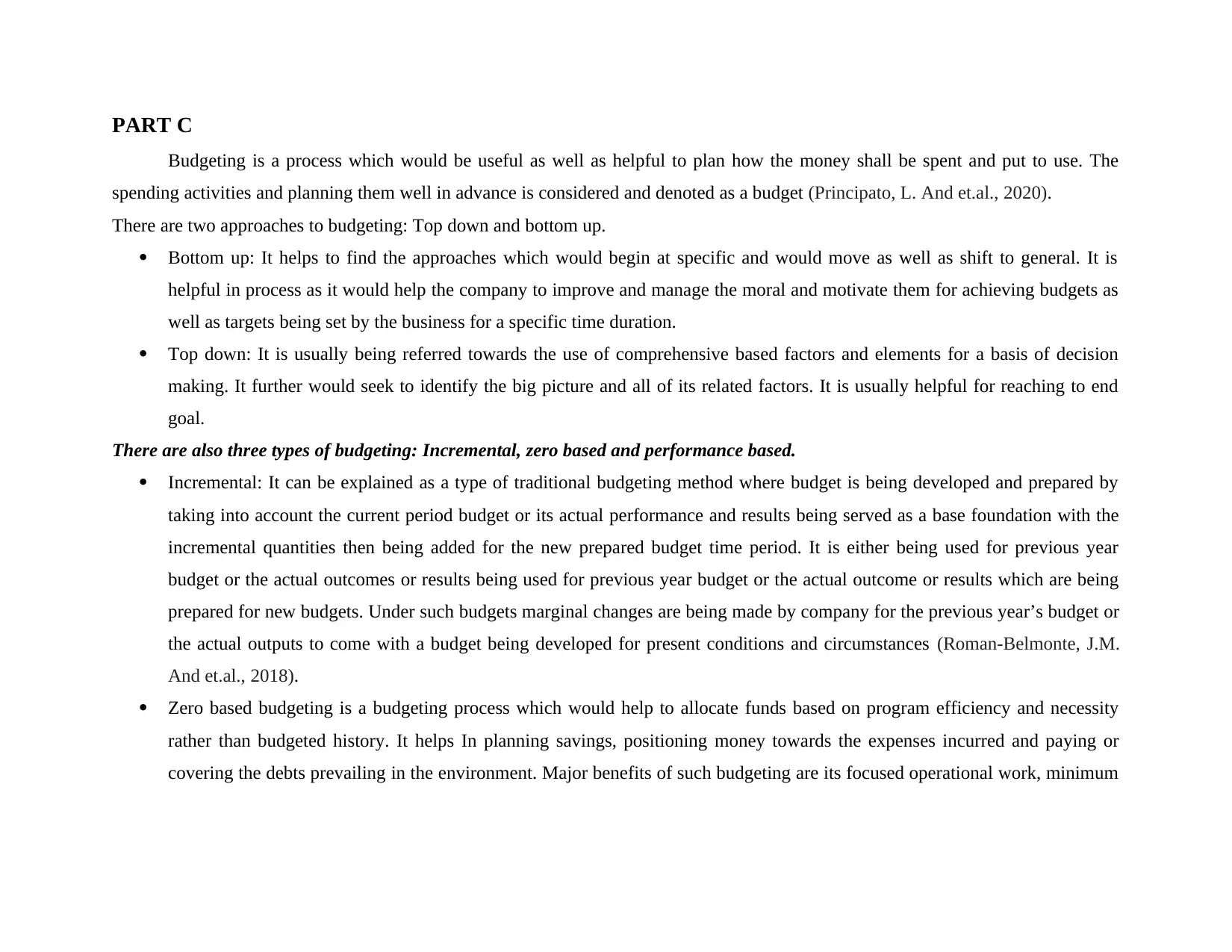
PART C
Budgeting is a process which would be useful as well as helpful to plan how the money shall be spent and put to use. The
spending activities and planning them well in advance is considered and denoted as a budget (Principato, L. And et.al., 2020).
There are two approaches to budgeting: Top down and bottom up.
Bottom up: It helps to find the approaches which would begin at specific and would move as well as shift to general. It is
helpful in process as it would help the company to improve and manage the moral and motivate them for achieving budgets as
well as targets being set by the business for a specific time duration.
Top down: It is usually being referred towards the use of comprehensive based factors and elements for a basis of decision
making. It further would seek to identify the big picture and all of its related factors. It is usually helpful for reaching to end
goal.
There are also three types of budgeting: Incremental, zero based and performance based.
Incremental: It can be explained as a type of traditional budgeting method where budget is being developed and prepared by
taking into account the current period budget or its actual performance and results being served as a base foundation with the
incremental quantities then being added for the new prepared budget time period. It is either being used for previous year
budget or the actual outcomes or results being used for previous year budget or the actual outcome or results which are being
prepared for new budgets. Under such budgets marginal changes are being made by company for the previous year’s budget or
the actual outputs to come with a budget being developed for present conditions and circumstances (Roman-Belmonte, J.M.
And et.al., 2018).
Zero based budgeting is a budgeting process which would help to allocate funds based on program efficiency and necessity
rather than budgeted history. It helps In planning savings, positioning money towards the expenses incurred and paying or
covering the debts prevailing in the environment. Major benefits of such budgeting are its focused operational work, minimum
Budgeting is a process which would be useful as well as helpful to plan how the money shall be spent and put to use. The
spending activities and planning them well in advance is considered and denoted as a budget (Principato, L. And et.al., 2020).
There are two approaches to budgeting: Top down and bottom up.
Bottom up: It helps to find the approaches which would begin at specific and would move as well as shift to general. It is
helpful in process as it would help the company to improve and manage the moral and motivate them for achieving budgets as
well as targets being set by the business for a specific time duration.
Top down: It is usually being referred towards the use of comprehensive based factors and elements for a basis of decision
making. It further would seek to identify the big picture and all of its related factors. It is usually helpful for reaching to end
goal.
There are also three types of budgeting: Incremental, zero based and performance based.
Incremental: It can be explained as a type of traditional budgeting method where budget is being developed and prepared by
taking into account the current period budget or its actual performance and results being served as a base foundation with the
incremental quantities then being added for the new prepared budget time period. It is either being used for previous year
budget or the actual outcomes or results being used for previous year budget or the actual outcome or results which are being
prepared for new budgets. Under such budgets marginal changes are being made by company for the previous year’s budget or
the actual outputs to come with a budget being developed for present conditions and circumstances (Roman-Belmonte, J.M.
And et.al., 2018).
Zero based budgeting is a budgeting process which would help to allocate funds based on program efficiency and necessity
rather than budgeted history. It helps In planning savings, positioning money towards the expenses incurred and paying or
covering the debts prevailing in the environment. Major benefits of such budgeting are its focused operational work, minimum
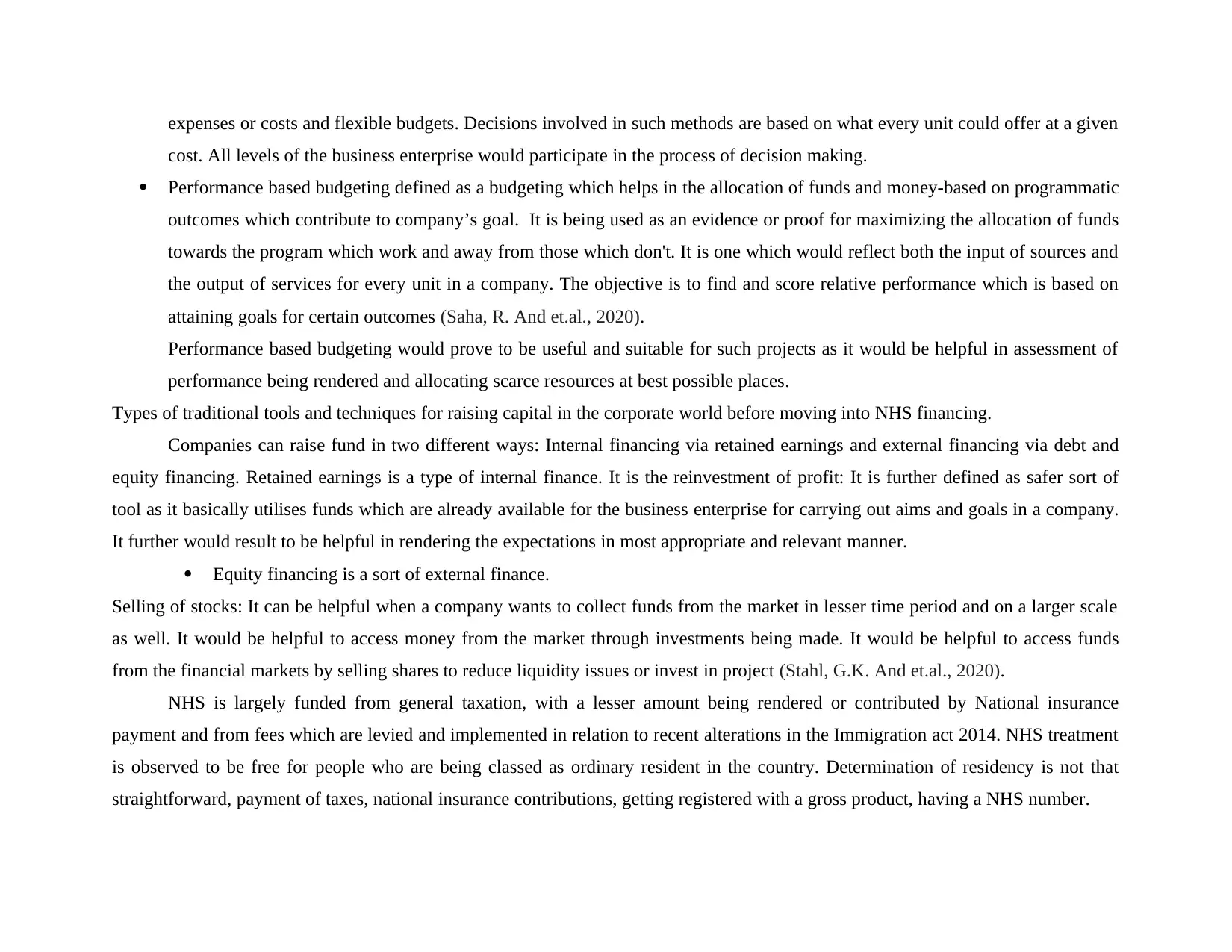
expenses or costs and flexible budgets. Decisions involved in such methods are based on what every unit could offer at a given
cost. All levels of the business enterprise would participate in the process of decision making.
Performance based budgeting defined as a budgeting which helps in the allocation of funds and money-based on programmatic
outcomes which contribute to company’s goal. It is being used as an evidence or proof for maximizing the allocation of funds
towards the program which work and away from those which don't. It is one which would reflect both the input of sources and
the output of services for every unit in a company. The objective is to find and score relative performance which is based on
attaining goals for certain outcomes (Saha, R. And et.al., 2020).
Performance based budgeting would prove to be useful and suitable for such projects as it would be helpful in assessment of
performance being rendered and allocating scarce resources at best possible places.
Types of traditional tools and techniques for raising capital in the corporate world before moving into NHS financing.
Companies can raise fund in two different ways: Internal financing via retained earnings and external financing via debt and
equity financing. Retained earnings is a type of internal finance. It is the reinvestment of profit: It is further defined as safer sort of
tool as it basically utilises funds which are already available for the business enterprise for carrying out aims and goals in a company.
It further would result to be helpful in rendering the expectations in most appropriate and relevant manner.
Equity financing is a sort of external finance.
Selling of stocks: It can be helpful when a company wants to collect funds from the market in lesser time period and on a larger scale
as well. It would be helpful to access money from the market through investments being made. It would be helpful to access funds
from the financial markets by selling shares to reduce liquidity issues or invest in project (Stahl, G.K. And et.al., 2020).
NHS is largely funded from general taxation, with a lesser amount being rendered or contributed by National insurance
payment and from fees which are levied and implemented in relation to recent alterations in the Immigration act 2014. NHS treatment
is observed to be free for people who are being classed as ordinary resident in the country. Determination of residency is not that
straightforward, payment of taxes, national insurance contributions, getting registered with a gross product, having a NHS number.
cost. All levels of the business enterprise would participate in the process of decision making.
Performance based budgeting defined as a budgeting which helps in the allocation of funds and money-based on programmatic
outcomes which contribute to company’s goal. It is being used as an evidence or proof for maximizing the allocation of funds
towards the program which work and away from those which don't. It is one which would reflect both the input of sources and
the output of services for every unit in a company. The objective is to find and score relative performance which is based on
attaining goals for certain outcomes (Saha, R. And et.al., 2020).
Performance based budgeting would prove to be useful and suitable for such projects as it would be helpful in assessment of
performance being rendered and allocating scarce resources at best possible places.
Types of traditional tools and techniques for raising capital in the corporate world before moving into NHS financing.
Companies can raise fund in two different ways: Internal financing via retained earnings and external financing via debt and
equity financing. Retained earnings is a type of internal finance. It is the reinvestment of profit: It is further defined as safer sort of
tool as it basically utilises funds which are already available for the business enterprise for carrying out aims and goals in a company.
It further would result to be helpful in rendering the expectations in most appropriate and relevant manner.
Equity financing is a sort of external finance.
Selling of stocks: It can be helpful when a company wants to collect funds from the market in lesser time period and on a larger scale
as well. It would be helpful to access money from the market through investments being made. It would be helpful to access funds
from the financial markets by selling shares to reduce liquidity issues or invest in project (Stahl, G.K. And et.al., 2020).
NHS is largely funded from general taxation, with a lesser amount being rendered or contributed by National insurance
payment and from fees which are levied and implemented in relation to recent alterations in the Immigration act 2014. NHS treatment
is observed to be free for people who are being classed as ordinary resident in the country. Determination of residency is not that
straightforward, payment of taxes, national insurance contributions, getting registered with a gross product, having a NHS number.
Secure Best Marks with AI Grader
Need help grading? Try our AI Grader for instant feedback on your assignments.
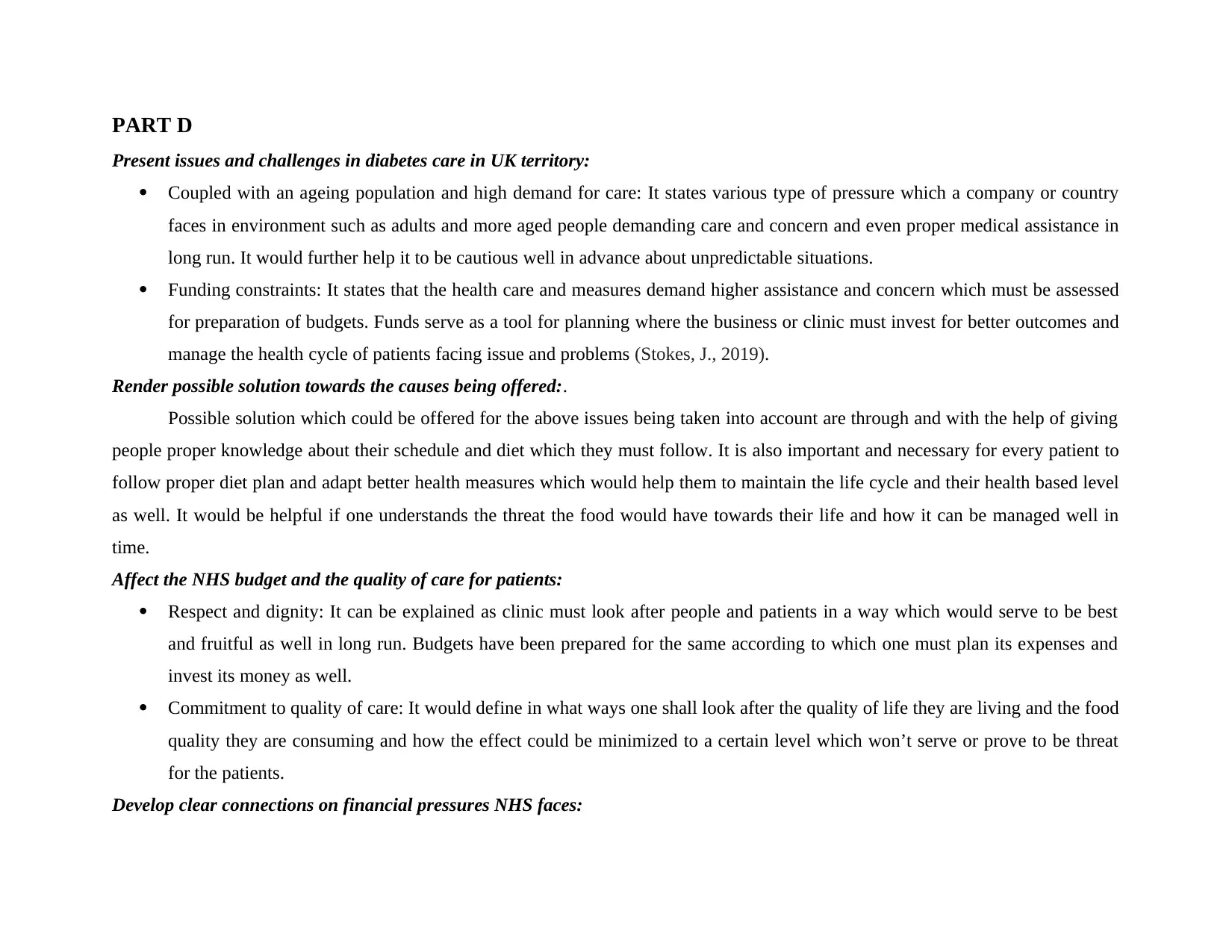
PART D
Present issues and challenges in diabetes care in UK territory:
Coupled with an ageing population and high demand for care: It states various type of pressure which a company or country
faces in environment such as adults and more aged people demanding care and concern and even proper medical assistance in
long run. It would further help it to be cautious well in advance about unpredictable situations.
Funding constraints: It states that the health care and measures demand higher assistance and concern which must be assessed
for preparation of budgets. Funds serve as a tool for planning where the business or clinic must invest for better outcomes and
manage the health cycle of patients facing issue and problems (Stokes, J., 2019).
Render possible solution towards the causes being offered:.
Possible solution which could be offered for the above issues being taken into account are through and with the help of giving
people proper knowledge about their schedule and diet which they must follow. It is also important and necessary for every patient to
follow proper diet plan and adapt better health measures which would help them to maintain the life cycle and their health based level
as well. It would be helpful if one understands the threat the food would have towards their life and how it can be managed well in
time.
Affect the NHS budget and the quality of care for patients:
Respect and dignity: It can be explained as clinic must look after people and patients in a way which would serve to be best
and fruitful as well in long run. Budgets have been prepared for the same according to which one must plan its expenses and
invest its money as well.
Commitment to quality of care: It would define in what ways one shall look after the quality of life they are living and the food
quality they are consuming and how the effect could be minimized to a certain level which won’t serve or prove to be threat
for the patients.
Develop clear connections on financial pressures NHS faces:
Present issues and challenges in diabetes care in UK territory:
Coupled with an ageing population and high demand for care: It states various type of pressure which a company or country
faces in environment such as adults and more aged people demanding care and concern and even proper medical assistance in
long run. It would further help it to be cautious well in advance about unpredictable situations.
Funding constraints: It states that the health care and measures demand higher assistance and concern which must be assessed
for preparation of budgets. Funds serve as a tool for planning where the business or clinic must invest for better outcomes and
manage the health cycle of patients facing issue and problems (Stokes, J., 2019).
Render possible solution towards the causes being offered:.
Possible solution which could be offered for the above issues being taken into account are through and with the help of giving
people proper knowledge about their schedule and diet which they must follow. It is also important and necessary for every patient to
follow proper diet plan and adapt better health measures which would help them to maintain the life cycle and their health based level
as well. It would be helpful if one understands the threat the food would have towards their life and how it can be managed well in
time.
Affect the NHS budget and the quality of care for patients:
Respect and dignity: It can be explained as clinic must look after people and patients in a way which would serve to be best
and fruitful as well in long run. Budgets have been prepared for the same according to which one must plan its expenses and
invest its money as well.
Commitment to quality of care: It would define in what ways one shall look after the quality of life they are living and the food
quality they are consuming and how the effect could be minimized to a certain level which won’t serve or prove to be threat
for the patients.
Develop clear connections on financial pressures NHS faces:
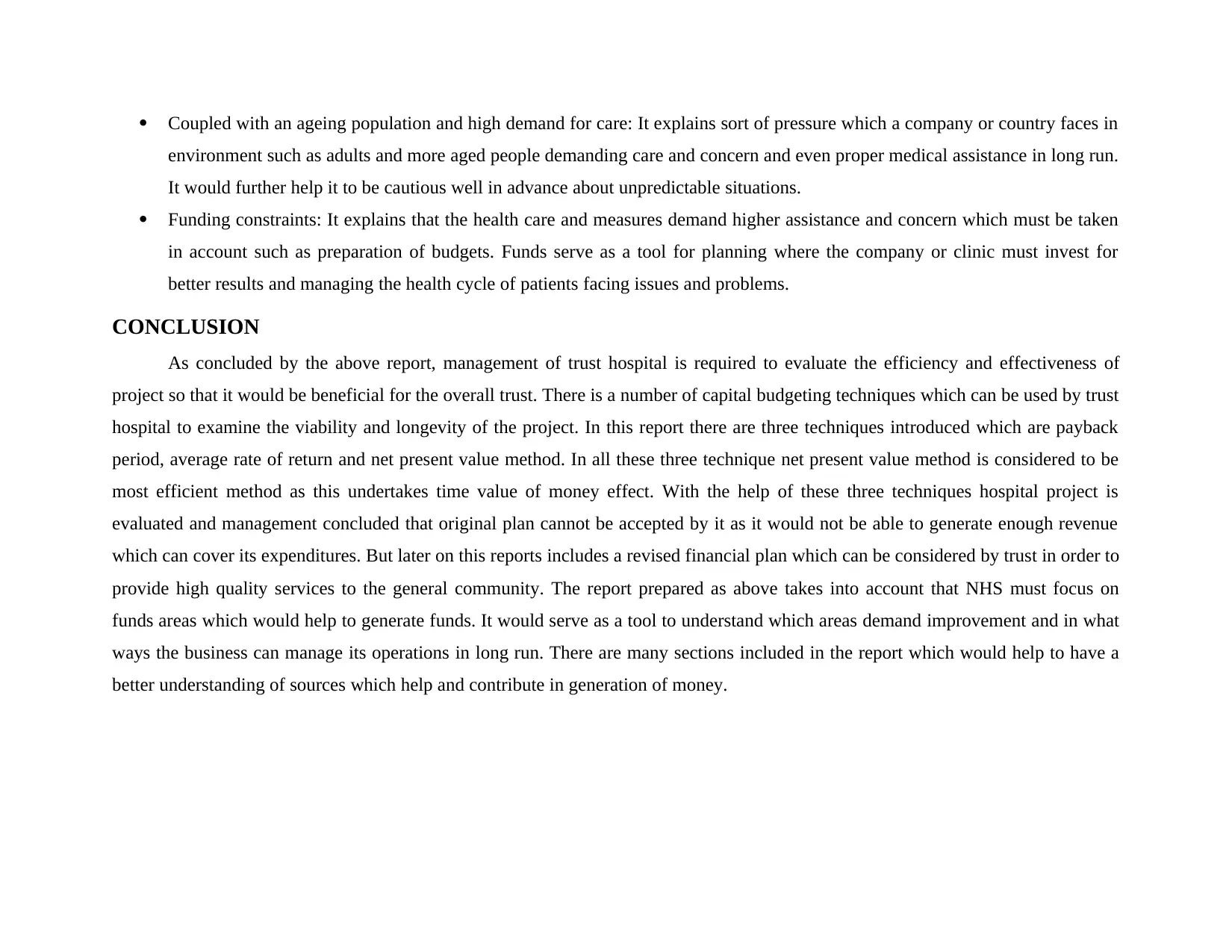
Coupled with an ageing population and high demand for care: It explains sort of pressure which a company or country faces in
environment such as adults and more aged people demanding care and concern and even proper medical assistance in long run.
It would further help it to be cautious well in advance about unpredictable situations.
Funding constraints: It explains that the health care and measures demand higher assistance and concern which must be taken
in account such as preparation of budgets. Funds serve as a tool for planning where the company or clinic must invest for
better results and managing the health cycle of patients facing issues and problems.
CONCLUSION
As concluded by the above report, management of trust hospital is required to evaluate the efficiency and effectiveness of
project so that it would be beneficial for the overall trust. There is a number of capital budgeting techniques which can be used by trust
hospital to examine the viability and longevity of the project. In this report there are three techniques introduced which are payback
period, average rate of return and net present value method. In all these three technique net present value method is considered to be
most efficient method as this undertakes time value of money effect. With the help of these three techniques hospital project is
evaluated and management concluded that original plan cannot be accepted by it as it would not be able to generate enough revenue
which can cover its expenditures. But later on this reports includes a revised financial plan which can be considered by trust in order to
provide high quality services to the general community. The report prepared as above takes into account that NHS must focus on
funds areas which would help to generate funds. It would serve as a tool to understand which areas demand improvement and in what
ways the business can manage its operations in long run. There are many sections included in the report which would help to have a
better understanding of sources which help and contribute in generation of money.
environment such as adults and more aged people demanding care and concern and even proper medical assistance in long run.
It would further help it to be cautious well in advance about unpredictable situations.
Funding constraints: It explains that the health care and measures demand higher assistance and concern which must be taken
in account such as preparation of budgets. Funds serve as a tool for planning where the company or clinic must invest for
better results and managing the health cycle of patients facing issues and problems.
CONCLUSION
As concluded by the above report, management of trust hospital is required to evaluate the efficiency and effectiveness of
project so that it would be beneficial for the overall trust. There is a number of capital budgeting techniques which can be used by trust
hospital to examine the viability and longevity of the project. In this report there are three techniques introduced which are payback
period, average rate of return and net present value method. In all these three technique net present value method is considered to be
most efficient method as this undertakes time value of money effect. With the help of these three techniques hospital project is
evaluated and management concluded that original plan cannot be accepted by it as it would not be able to generate enough revenue
which can cover its expenditures. But later on this reports includes a revised financial plan which can be considered by trust in order to
provide high quality services to the general community. The report prepared as above takes into account that NHS must focus on
funds areas which would help to generate funds. It would serve as a tool to understand which areas demand improvement and in what
ways the business can manage its operations in long run. There are many sections included in the report which would help to have a
better understanding of sources which help and contribute in generation of money.

Paraphrase This Document
Need a fresh take? Get an instant paraphrase of this document with our AI Paraphraser
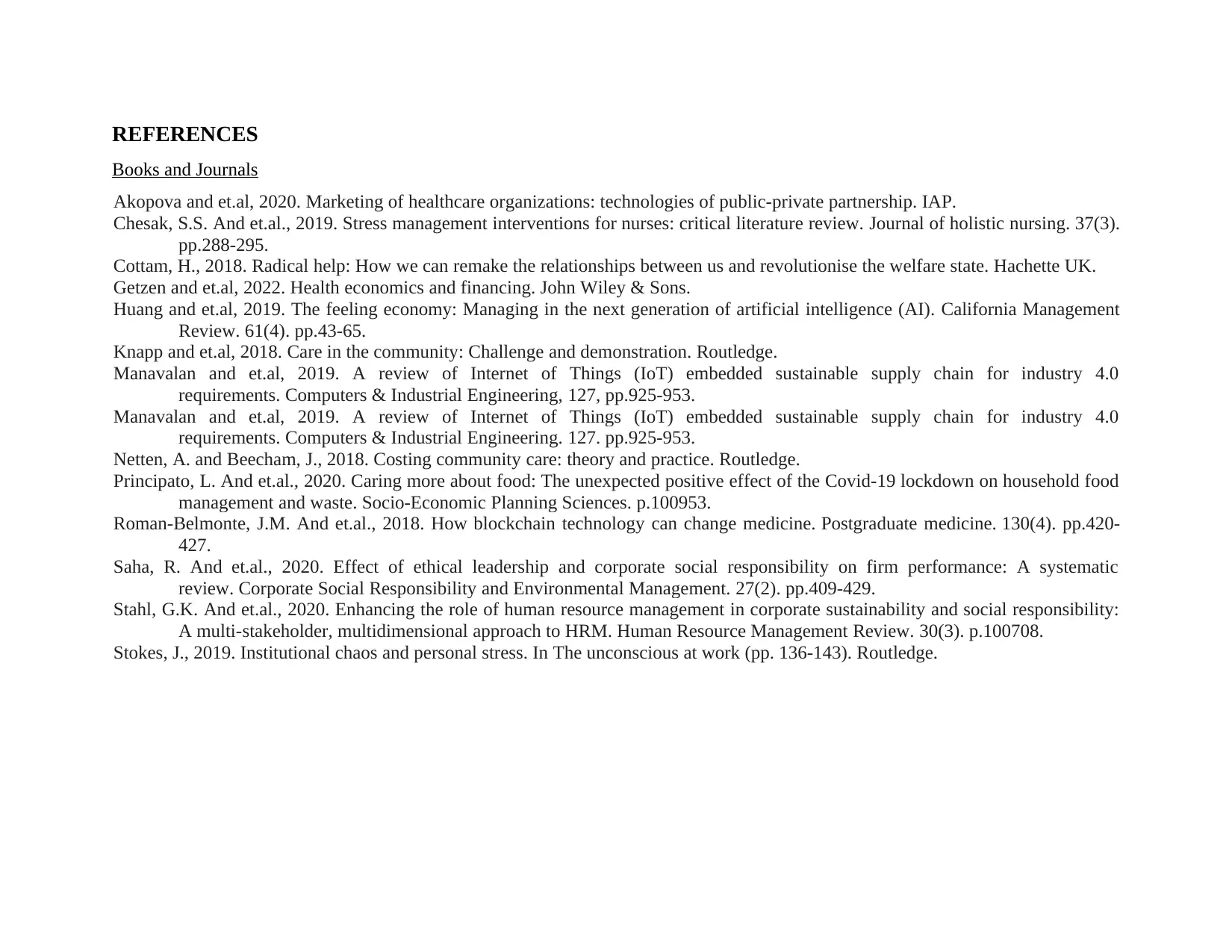
REFERENCES
Books and Journals
Akopova and et.al, 2020. Marketing of healthcare organizations: technologies of public-private partnership. IAP.
Chesak, S.S. And et.al., 2019. Stress management interventions for nurses: critical literature review. Journal of holistic nursing. 37(3).
pp.288-295.
Cottam, H., 2018. Radical help: How we can remake the relationships between us and revolutionise the welfare state. Hachette UK.
Getzen and et.al, 2022. Health economics and financing. John Wiley & Sons.
Huang and et.al, 2019. The feeling economy: Managing in the next generation of artificial intelligence (AI). California Management
Review. 61(4). pp.43-65.
Knapp and et.al, 2018. Care in the community: Challenge and demonstration. Routledge.
Manavalan and et.al, 2019. A review of Internet of Things (IoT) embedded sustainable supply chain for industry 4.0
requirements. Computers & Industrial Engineering, 127, pp.925-953.
Manavalan and et.al, 2019. A review of Internet of Things (IoT) embedded sustainable supply chain for industry 4.0
requirements. Computers & Industrial Engineering. 127. pp.925-953.
Netten, A. and Beecham, J., 2018. Costing community care: theory and practice. Routledge.
Principato, L. And et.al., 2020. Caring more about food: The unexpected positive effect of the Covid-19 lockdown on household food
management and waste. Socio-Economic Planning Sciences. p.100953.
Roman-Belmonte, J.M. And et.al., 2018. How blockchain technology can change medicine. Postgraduate medicine. 130(4). pp.420-
427.
Saha, R. And et.al., 2020. Effect of ethical leadership and corporate social responsibility on firm performance: A systematic
review. Corporate Social Responsibility and Environmental Management. 27(2). pp.409-429.
Stahl, G.K. And et.al., 2020. Enhancing the role of human resource management in corporate sustainability and social responsibility:
A multi-stakeholder, multidimensional approach to HRM. Human Resource Management Review. 30(3). p.100708.
Stokes, J., 2019. Institutional chaos and personal stress. In The unconscious at work (pp. 136-143). Routledge.
Books and Journals
Akopova and et.al, 2020. Marketing of healthcare organizations: technologies of public-private partnership. IAP.
Chesak, S.S. And et.al., 2019. Stress management interventions for nurses: critical literature review. Journal of holistic nursing. 37(3).
pp.288-295.
Cottam, H., 2018. Radical help: How we can remake the relationships between us and revolutionise the welfare state. Hachette UK.
Getzen and et.al, 2022. Health economics and financing. John Wiley & Sons.
Huang and et.al, 2019. The feeling economy: Managing in the next generation of artificial intelligence (AI). California Management
Review. 61(4). pp.43-65.
Knapp and et.al, 2018. Care in the community: Challenge and demonstration. Routledge.
Manavalan and et.al, 2019. A review of Internet of Things (IoT) embedded sustainable supply chain for industry 4.0
requirements. Computers & Industrial Engineering, 127, pp.925-953.
Manavalan and et.al, 2019. A review of Internet of Things (IoT) embedded sustainable supply chain for industry 4.0
requirements. Computers & Industrial Engineering. 127. pp.925-953.
Netten, A. and Beecham, J., 2018. Costing community care: theory and practice. Routledge.
Principato, L. And et.al., 2020. Caring more about food: The unexpected positive effect of the Covid-19 lockdown on household food
management and waste. Socio-Economic Planning Sciences. p.100953.
Roman-Belmonte, J.M. And et.al., 2018. How blockchain technology can change medicine. Postgraduate medicine. 130(4). pp.420-
427.
Saha, R. And et.al., 2020. Effect of ethical leadership and corporate social responsibility on firm performance: A systematic
review. Corporate Social Responsibility and Environmental Management. 27(2). pp.409-429.
Stahl, G.K. And et.al., 2020. Enhancing the role of human resource management in corporate sustainability and social responsibility:
A multi-stakeholder, multidimensional approach to HRM. Human Resource Management Review. 30(3). p.100708.
Stokes, J., 2019. Institutional chaos and personal stress. In The unconscious at work (pp. 136-143). Routledge.
1 out of 20
Your All-in-One AI-Powered Toolkit for Academic Success.
+13062052269
info@desklib.com
Available 24*7 on WhatsApp / Email
![[object Object]](/_next/static/media/star-bottom.7253800d.svg)
Unlock your academic potential
© 2024 | Zucol Services PVT LTD | All rights reserved.

